King Francis Phoebus is not very well-known in today's Navarre. He died at the age of just fourteen, after inheriting the throne from his grandmother Eleanor of Trastamara. He was a member of the Foix family, sovereign lord of Bearn through his grandfather's succession. He held the Navarrese crown for four years, between January 1479 and 1483, before dying and passing it to his sister Catherine. Some believe he died of tuberculosis, others believe he was poisoned by the very catholic and liar Ferdinand; in any case he did not have enough time to enjoy life.
His coins are rare, very rare, especially those belonging to the Kingdom of Navarre. The Bearnese coins started being minted earlier than those of Navarre, as Francis was already Lord of Bearn from 1472 onwards.
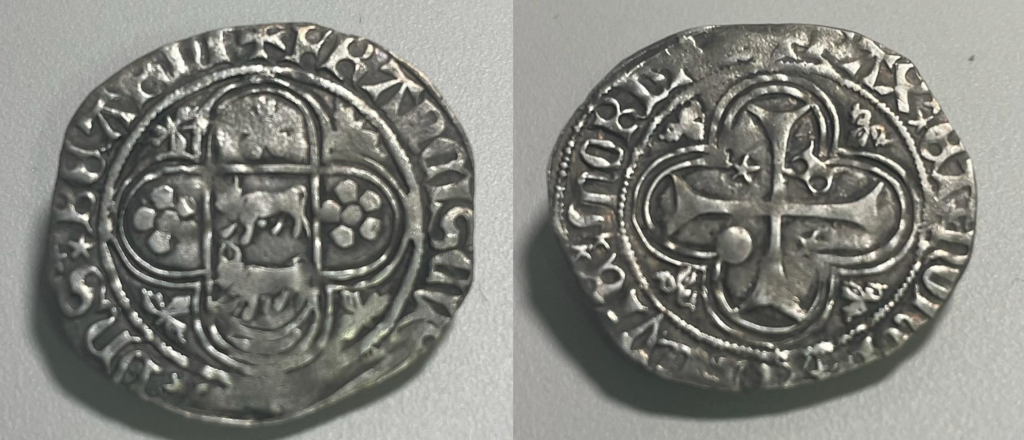
Silver blank struck in Morlaas in the name of Francis Phoebus, Lord of Bearn (1472-1483) – 2.74 gr, 24.5 mm diameter
Obverse: FRANCISCVS*F*D*G*DNS*BEARNI
Reverse: PAX*ET*HONOR*FORQVIE*MORLAN F letter and a besant
DIEGO LOPEZ COLLECTION
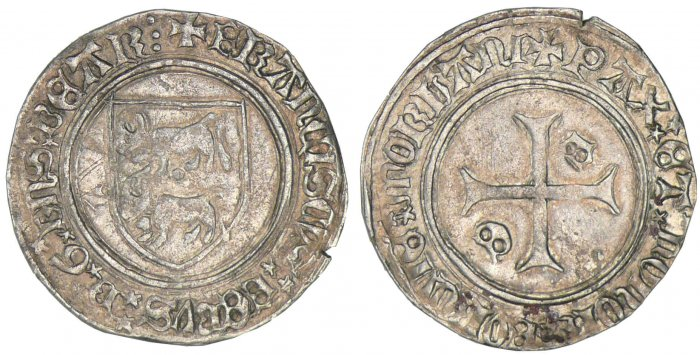
Silver blank struck in Morlaas in the name of Francis Phoebus Lord of Bearn (1472-1483) – 2.69 gr, 27mm diameter
Obverse: FRANCISCVS*FEBVS*D*G*DNS*BEAR:
Reverse: PAX*ET*HONOR*FORQVIE*MORLANI F and E letters
MONNAIES D'ANTAN, AUCTION 7, LOT 853 21.05.2010
In the case of Navarre, coinage began in December 1481, around the time of Francis' coronation. In fact, although the Navarrese coins of Francis are extremely rare, we know the exact and detailed history of these coins thanks to the coinage accounts written by the coinage guard Pedro Marzilla de Caparroso. These accounts, which consist of 44 handwritten pages, are currently kept in the General Archive of Navarre, under the reference of Document 21, pertaining to Box 164.
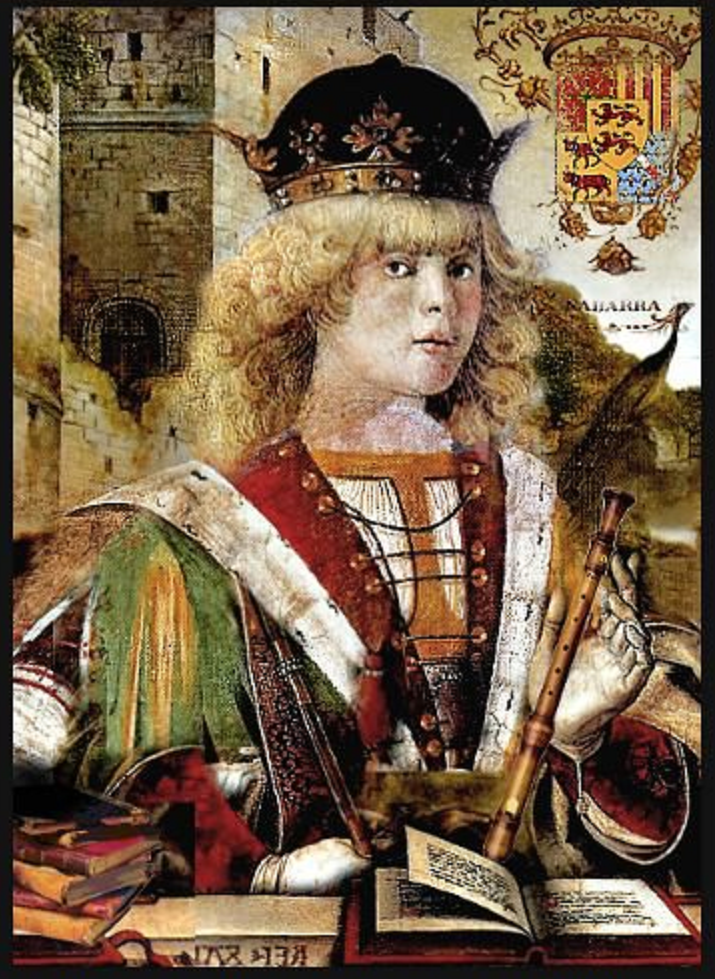
King Francis Phoebus of Navarre (1479-1483)
These coinage accounts tell us all the details, quantities and variations of the coins minted between December 20th 1481 and same day in 1486. Although Francis himself died within these five years, the accounts confirm that all the coins during this period were minted with the same weight, law and design (die and pile) compared to those originally struck.
„Et empues de fetho el dcho coronamyento Real del dcho senor Rey et procuprado de fazer la dta moneda que lo bolumtat de dchos q lordeno desus derechos del dcho senor Rey et por otro nuebo mandamiento dado por el lugartenyente de gobernador dla muy alta y serenissima Reyna Dona Cateryhna natural senora que mandado gremiar la dcha moneda de aquella mesima ley et talla con aquellos mesimos cuynos et tipos del dcho Senor Rey Febo de gloriosa memoria mandando bater como contiene porel dcho primer mandamyento et assi sefizo segunt se sigue el thenor del quoal dicho mandamyento de nuebo dado et en la forma segheido que se signe"
As mentioned, these accounts provide us with very detailed information. First of all, we have the names of all the high ranked officials who were involved in these coinages:
- Martin d'Aoyz, Mint Master. The first minting document of Queen Blanca dated in 1428 already mentions a merchant named Martin d'Aoyz and as we can see, the same family remained involved in minting coins even throughout the 16th century.
- Pedro Marzilla de Caparroso, He was the guard of coinage in the royal tower and the general guard of the coinage struck in the entire kingdom of Navarre. His salary was twelve and a half pounds (livre) for each worked month and was paid from the revenues of the seigniorage.
- Miguel de Espinal, assayer. His monthly salary was seven and a half livres and was paid from the revenues of the seigniorage.
- Martin Cruzat General of the coinage. His monthly salary was seven and a half pounds and was paid from the revenues of the seigniorage. His duties seem to have been related to controlling and supervising other senior officials.
- Pierres Pelayn a carver of piles (bottom die) and hammer (upper) dies. His monthly salary was five pounds and was paid from the revenues of the seigniorage.
- Peton de Sant Johan or Peton of Saint John, producer of steel piles and dies. He was paid 5 shillings (sous/sueldos) per pile and 2 and a half shillings per hammer die from the seigniorage revenues.
- There is also information about a counterguard or deputy guard, with the same salary as Pedro Marzilla, but his name is not mentioned anywhere.
We do not have a document of the agreement signed between Martin d'Aoyz and the king, or rather said, between Martin d'Aoyz and Cardinal Pedro of Foix, viceroy of Navarre, but the accounts of Pedro Marzilla report us about the coinage law published by Pedro of Foix:

Courtesy of the General Archive of Navarre AGN, Box 164, Subentry of Document 21
Don Pedro Cardenal infante e viso Rey de Nabarra por el serenysimo principe Don Frances Febo por la gra de dios Rey de nabarra, duque de Nemours e Gandia, senyor de Montblanc e de Penyafiel Conde de Foix Senyor de Bearn Conde de Bigorra y de Ribagorza senor de ciuddat de Balaguer e par de Francia. Aqueles la pnte beran et oyran salut, como sea por fuero y ley del dcho regno de Nabarra que los Reyes d’aquel ensu buen abenturado coronamiento dcho mandan fazer moneda nueba en la muy noble ciudad de Pamp et d’aquella derramar en sta Maria dela dcha ciudat el dia de su Real Coronamiento.
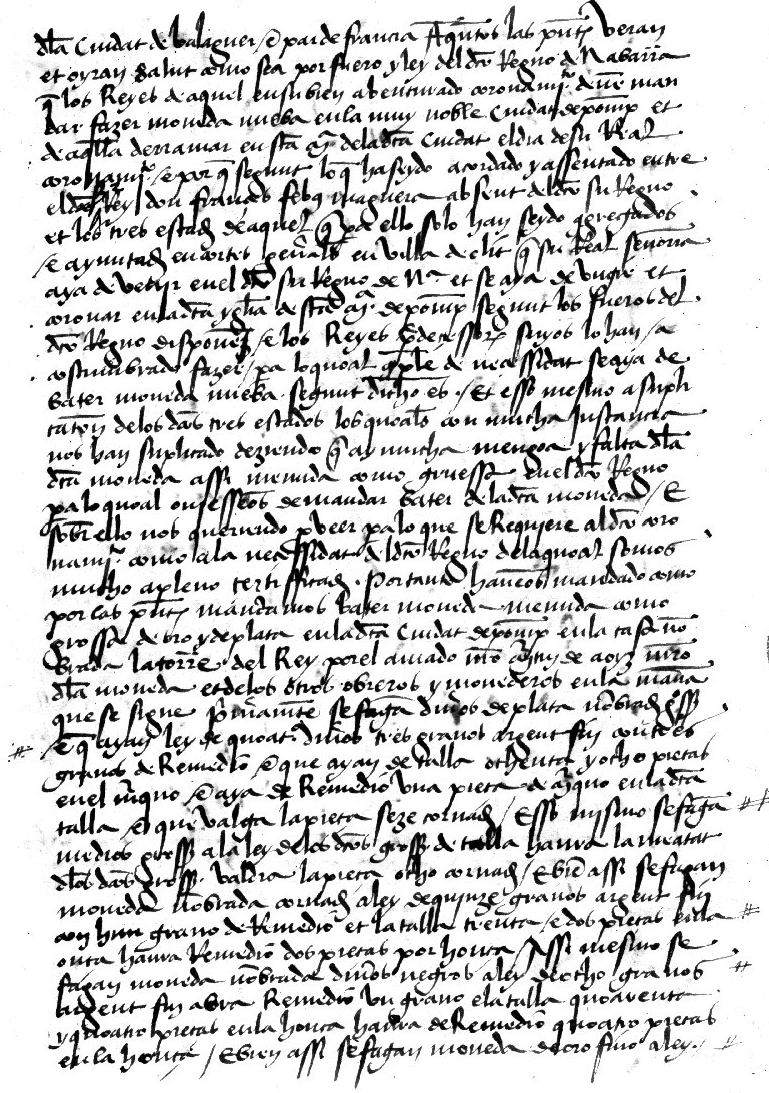
Courtesy of the General Archive of Navarre AGN, Box 164, Subentry of Document 21
Et por que segun lo que ha seydo acordado y asentado entre el dcho Rey don Francesco Febo magnera absent del dcho su Regno et los sues stados de aquel q por ello solo han seydo governados e ayuntados en cortes senaldos en billa d’Olite q su real sernoria aya de benyr en el dcho su regno de Navarra et se aya de Ungir et coronar en la dcha yglesia de Sant Ma de Pamplona segun los fueros del dcho Regno disponen e los Reyes y demasses senyos lo hay acostumbrado fazer/pa lo quoal a pte de neassidar seaya de bater moneda nueba segunt dicho es. Et esso mesmo a indicacion de los dchos tres estados los quales con mucha instancia nos han indicado deziendo q ay mucha mengoa y falta dla dcha moneda assi menuda como gruessa en el dcho Regno por lo qual onsesseos demandar bater de la dcha moneda.E por ello nos queriendo probeer pa lo que se requyere al dcho coronamiento como ala necessidad del dcho Regno delaqual somos mucho apleno restaffurar. Por tanto havemos mandado como por las prtes mandamos bater moneda menuda como grossa de oro y de plata en la dcha ciudat de pomp en la casa nombrada la torre del Rey por el amado mtro Martin de Aoyz mtr dla moneda etdelos oficiales obreros y monederos enla manera que se signe por mamdat se faga dineros de plata nombradas grosses e q ayan ley de quoatr dneros tres granos argent fin con tres granos de Remedio e que ayan de talla ochenta y ocho piezas en el marquo e aya de Remedio una pieza d marquo en la dcha talla et que balga lapieza seze cornados. Esso mismo sefaga medios grosses a la ley de delos dchos grosses d talla haura la meitat dlos dchos grosses baldra la pieza ocho cornados. Et assi se fagan moneda nombrada cornados aley de quinze granos argent fin con un grano de Remedio et la talla trenta e dos piezas en la onza haura Remedio dos piezas por honza. Assi mesmo se fagan moneda nombrada dineros negros ala ley deocho granos argent fin abra Remedio un grano ela talla quarentayquatro piezas en al honza haura deRemedio quatro piezas en la honza.
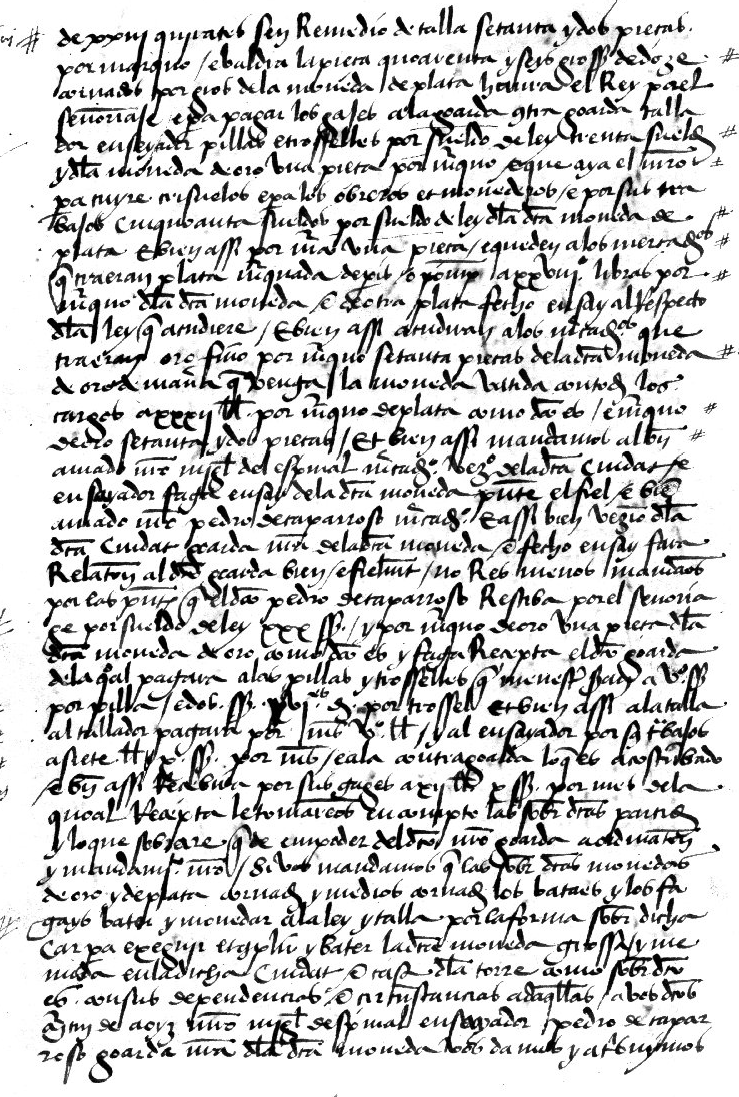
Courtesy of the General Archive of Navarre AGN, Box 164, Subentry of Document 21
Et assi sefagan moneda de oro fino a ley de XXIII quarats Sin Remedio de talla setenta y dos piezas por marquo. E baldra la pieza quarenta y seys gross de doze cornados por gros dela moneda de plata. Haura el rey porel senoriaje e pa pagar los gajes a la goarda ghr goarda tallador enseyador pillas et orfebhres por sueldo de ley treinta sueldos y dla moneda de oro una pieza por marquo. e que aya el mtro por suys desvelos epor los obreros et monederos e por sus trabajos cinquoanta sueldos por sueldo de ley dla dcha moneda de plata et bien assi por marqua una pieza. Equeden a los merdaderos q trajeran plata marquada de XII diners argent a XXVIII libras por marquo dla dcha moneda e de otra plata ferho ensay al Respecto dla ley q contudiere. E bien assi ayudaran a los merdadores que traeran oro fino por marquo setanta piezas de la dcha moneda de oro de manera q benga la moneda batida contados los cargos a XXXII libras por marquo deplata como dcho est emquo de oro setenta y dos piezas. Et bien assi mandamos al muy amado mtro Myguel del Espinal mercador bezino deladcha ciudat po ensayador faga ensay dela dcha moneda prnte el fiel e bien amado mtro Pedro decaparroso mercader e assi bien bezno dla dcha ciudat goarda mtro deladcha moneda e ferbo ensay fara Relatar al dcho goarda Buen efectuar no res menos mandado por las prtes q el dcho Pedro decaparroso Reciba por el senoriaje por sueldo deley XXX Sueldos y por marquo deoro una pieza dla dcha moneda de oro como da es y faga Recepta el dcho goarda delaqual pagara a las pillas y trqoqueles q necesitan a V Sueldos por pilla edos Sueldos y VI diners por troquel. Et bien assi a la talla al tallador pagara por mes V libras y al ensayador por sus trabajos a siete Libras y X Sueldos por mes. eala contragoarda lo q es acostumbrado e bien assi recibira por sus gages a XII libras X Sueldos por mes dela quoal Recepta le tomaredo en compto las sobre dchas parnos y lo que sobrare qde empoder del dcho mtro goarda administrar y mandamiento. Asi mandamos q las sobre dchas monedas de oro y de plata cornados y medios cornados los batare y los fagaro bater y monedar a la ley y talla por la forma sobre dicha tal para exegyr ergykar y bater la dcha moneda grossa y menuda en la dicha ciudat e casa dla torre como sobre dcho es consus dependencias e nztnfraunas adaqllas.
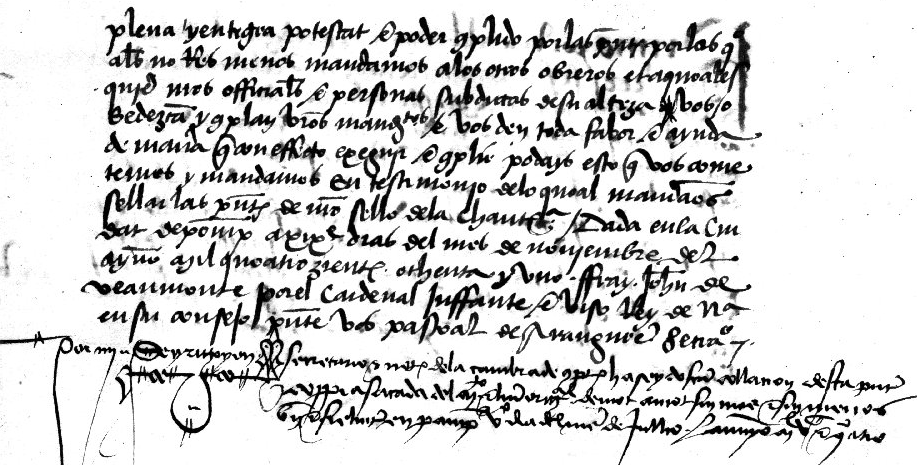
Courtesy of the General Archive of Navarre AGN, Box 164, Subentry of Document 21
A los dchos Martin de Aoyz mtro Mygel despynal ensayador Pedro de Caparroso goarda mtro dla dcha moneda los da plena yentegra potestat epoder qphido por las prntes por las q atb no Res menos mandamos alos otros obreros et aquoales qules ntros officiales e personas subditas de su alteza que los obedezca y q por las dchos mandamientos los den toda labor e ayuida de de manera q con essito eseguir e gphi podaimos esto q nos cometemos y mandamos. En testimonyo delo quoal mandamos sellar las pntes de ntro sello dela chancelleria. Dada en la ciudat depomp a XIX dias del mes de Noviembre del ayno a Mil quatroziente ochenta y uno. Fray Johan de Beaumonte por el Cardenal Inffante e viso Rey de Na en su Consejo prnte los Pascoal de Aranguren Serra y …..
A summary table of the features of the coins mentioned in the previous order would be as follows:
| Name | Value | Nominal Law (Fineness) | Number of Coins / Rough Mark | Nominal Weight (gr) | Legal Fineness Remedy/Tolerance | Legal Weight Remedy/Tolerance |
| Gold Coins Without Specific Name – Made following the Ducat Pattern | 46 / 47 / 48 Gross | 23 carats – 958 mils | 72 | 3.4 grams | Without Remedy | Without Remedy |
| Gros | 16 Cornado – 32 deniers | 4 deniers 3 grains – 343 Mils | 88 | 2.78 grams | 3 Grains | A Piece in a rough mark |
| Half-Gross | 8 Cornados – 16 deniers | 4 deniers 3 grains – 343 Mils | 176 | 1.39 grams | 3 Grains | 2 Pieces in a rough mark |
| Cornado | 2 Black Deniers | 15 Grains – 50 Mils | 256 | 0.95 grams | A grain, 24 Mils Aprox. with remedy | 2 Pieces in a Rough Ounce (16 Pieces in a rough Mark) |
| Black Money (Negrete) – Half Cornados | A Denier | 8 Grains – 27 Mils | 352 | 0.69 grams | A grain, 24 Mils Aprox. with remedy | 4 Pieces in a rough ounce (32 Pieces in a rough mark) |
Summary of the structure of the monetary system as explained by the decree of Viceroy Pedro de Foix
The gold coins followed the pattern of the Venetian ducat, but the name of these gold coins is not mentioned anywhere in the document. The equivalence of these gold coins was initially set at 46 gros of 12 cornados, that is, 4 livres and 12 sous. These 12 cornados gros were a unit of accounting, mirroring those used during the reign of Queen Blanche. The minting accounts show that the gold coins minted in 1482 were counted at 46 gros, but in 1484 and 1485 they were already worth 47 gros (4 livres and 14 sous) and in 1486 at 48 gros (4 livres and 16 sous).
In the case of gold coins, the payment arrangements were simple, there was no tolerance here. For every mark of pure gold brought by the merchants, 72 coins had to be minted (in fact, there was a small tolerance of one carat for the purity of the gold). The merchants would receive 70 of the minted gold coins and the remaining two, one for the king as seigniorage and the other for the mintmaster, in compensation for the minting costs.
| Name | Number of Coins / Rough Mark | Seigniorage Tax | Minting Costs | Merchants' per Mark Silver Payment |
| Gold Coins Without Names – Made in the Shape of Ducats | 72 | 1 | 1 | 70 |
Distribution of gold coinage output
Here is a page of account entries that reflects the minting of gold coins, shown in high-resolution, color photograph:
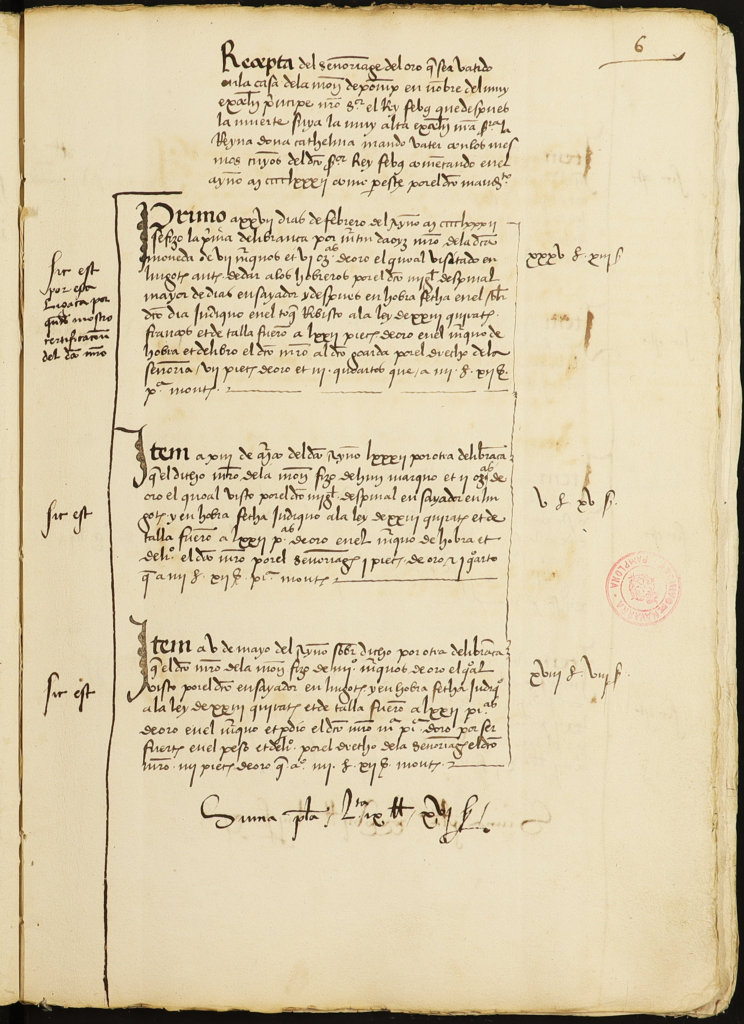
Courtesy of the General Archive of Navarre AGN, 164. Box 21. Index page 6 of the document
If we look at all these accounts of the minted gold coins, we can make the following summary:
| 1481 | 1482 | 1483 | 1484 | 1485 | 1486 | Total | |
| Number of minted Ducats | _ | 2.246 | _ | 1.111 | 310 | 1.131 | 4.798 |
| Rough Marks | _ | 31,20 | _ | 15,4375 | 4,3125 | 15,715635 | 66,67 |
| Seigniorage Tax Income (Livres, sous, deniers) | _ | 143L 13S 5D | _ | 72L 11S 1D | 20L 6S 5D | 75L 8S 10D | 311L 19S 9D |
| Value (gross) | 46 | 47 | 47 | 48 | |||
Gold coin mintage numbers and tax revenue
As we can see, a total of 4798 gold coins were minted in the five years, with a surplus of half a coin in each minting year, and it is therefore very possible that a total of exactly 4800 coins were minted (if so, one coin should be added to the numbers for 1484 and 1486). The largest gold coin quantity was minted in 1482, and no gold coins were minted in 1481 and 1483. As we will see later, only gold coins were minted in 1486, with no entries of silver or bronze coins. In total 15.63 kg (= 66.67*23/24*0.24475) gold were used to mint these 4,800 scarce coins over the five years. This is not a large amount and is probably an indication of the economic difficulties the kingdom was experiencing. However, the seigniorage tax revenues generated by the gold coins were comparatively significant, amounting to around 312 pounds.
To this day, only a few specimens of these gold coins have survived, although some of these presumed specimens are reproductions from the late 19th century; (MAN Museum MAN-194-874 or MZ-08738 of the Zaragoza Museum).
During an archaeological excavation in the Plaza Yesqueros in Murcia, a gold ducat of Francisco Febo was found in early 1993. This specimen is currently on display in the Santa Clara Museum in Murcia. With the permission of the Department of Culture of the Government of Murcia and the courtesy of the head of the Santa Clara Museum, here is a photo of this specimen:
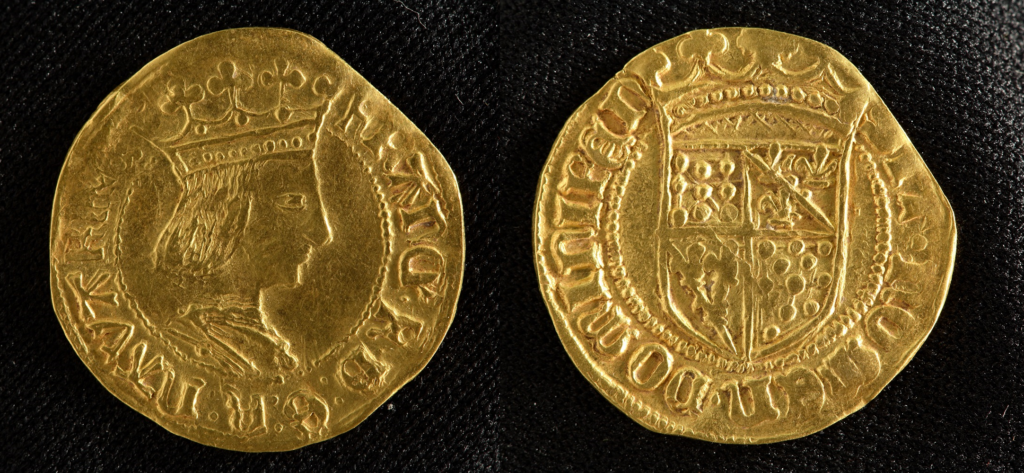
Gold coin minted in the name of King Francis Phoebus of Navarre (1479-1483) – 3.40 gr – 20.5mm diameter – 23 carat content (958 mils)
Obverse: FRANQ. F: D:G:R:NAVARRE
Reverse: SIT.NOMEN.DOMINIBEN
Courtesy of the Government of Murcia and the Santa Clara Museum 01.07.2024
The Vidal Quadras collection is said to have had one specimen, and the subsequent one is the only one with the same legends as the one mentioned in the Vidal Quadras collection booklet. This exemplar appeared at an auction in the United States in 2012; it raised up to $13,000 but has been controversial in recent years, with speculation that it could be a fake.
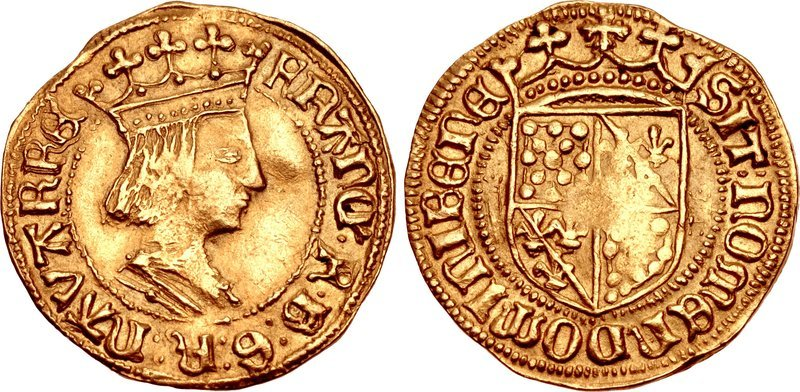
Gold coin minted in the name of King Francis Phoebus of Navarre (1479-1483) – 3.31 gr, 21mm diameter – 23 carat content (958 mils) – 13,000 USD Auction Result
Obverse: FRANQ. F: D:G:R:NAVARRE
Reverse: SIT:NOMENDOMINIBENE
CLASSICAL NUMISMATIC GROUP, INC., AUCTION 91, LOT 1251 19.09.2012
On June 24, 2024, the Tauler y Fau auction house put this other ducat up for sale. The auction price was 12,000 euros and it was purchased by the Government of Navarre with the intention of completing the numismatic collection of the Museum of Navarre.
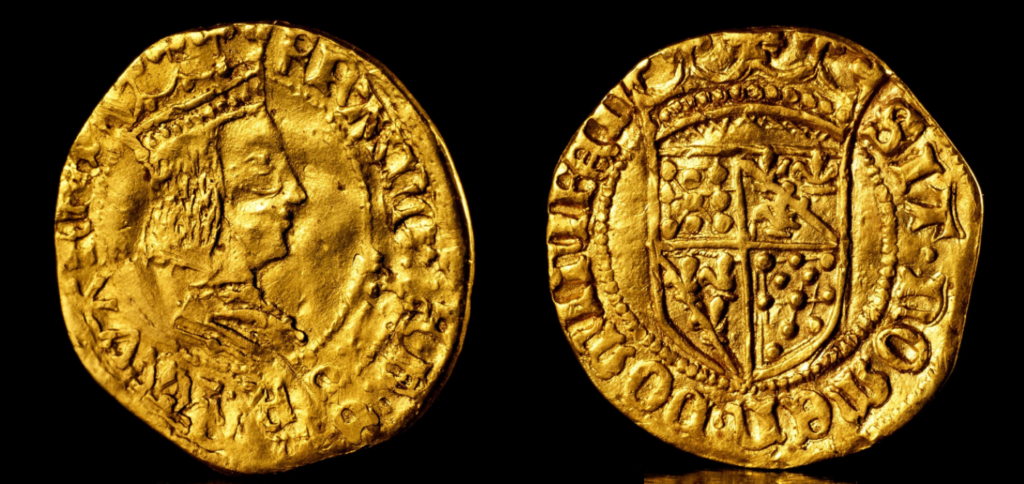
Gold coin minted in the name of King Francis Phoebus of Navarre (1479-1483) – 3.32 gr – 23 carat content (958 mils) – 12,000 EUR Auction
Obverse: FRANQ. F: D:G:R:NAVARRE
Reverse: SIT.NOMEN.DOMINIBEN
Tauler y Fau – Auction 144 Coleccion Principe de Viana – Lot 1306 – 24.06.2024
If we put these three specimens side by side, we can draw a couple of interesting conclusions:
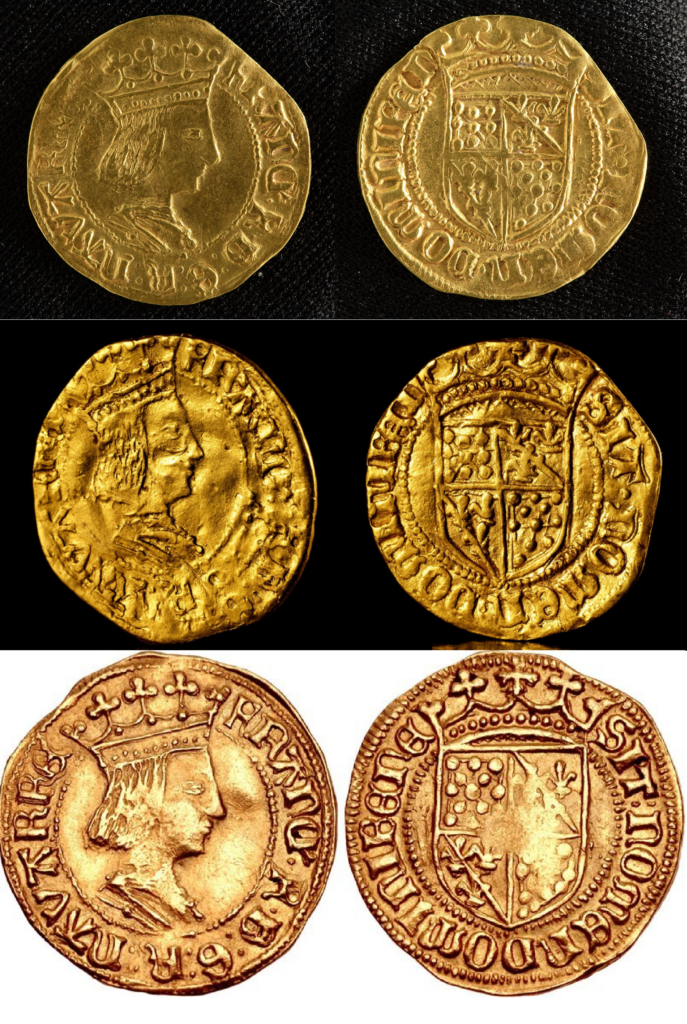
We can say that the first and second exemplars had the same die or stack on the reverse side. The obverse side may be the same for all copies, but in the case of the second copy, a completely accurate analysis would be necessary. Although the first and third copies had the same die or stack on the obverse side, the same is not true for the reverse side. All of this data would guarantee the legitimacy of the specimen sold at auction in the United States.
If we look at silver coins, let's start with the so-called gros and half gros. We have previously analyzed two different mintages of the so-called gros pieces, the ones of Charles II in Donapaleu (1352-1353) and the ones of Queen Blanca from 1432 (karlin bezala izendatuak). Nafarroako erresumako lehen gros aleek %58,33 ko zilar edukia eta 3,82 gramotako pisua bazuten, Blanka erreginarenak, 80 urteren buruan, % 48 zilar edukia eta 3,06 gramotako pisua zuten. Lehenek hamabi dirutako balioa bazuten, bigarrenek hogetalau dirutako (12 kornadotako) balioa zuten. Frantzisko Feborenak berriz, beste 50 urteren buruan, %34,3 zilar edukia eta 2,78 gramotako pisua zuten bitartean, balioa 32 dirutan (16 kornadotan) zuten. Aipatutako diru eta kornado hauek, garai hartako sistema monetarioaren oinarria baziren ere, pisu eta zilar edukia galtzen joan ziren etengabe.
But the minting accounts of these silver gros and half gros have another side that no one has examined. The amount to be paid to merchants for a pure silver mark, the payment of the seigniorage tax and the amounts required to be paid in minting costs and the mintmaster's salary are clearly explained in the minting order of Viceroy Pedro of Foix. But what was the monetary flow generated by a silver mark and how does it compare to all these payments? Here is the analysis:
| Name | Rough Marks Created from a Silver Mark | Number of Coins Produced from a Silver Mark | Seigniorage Tax | Minting Costs | Merchants' per Mark Silver Payment | Total | Monetary Outcome generated from a Silver Mark | Remaining discrepancy of Monetary outcome |
| Gros | 2,9090 | 256 | 30 Sous/Sueldos | 50 Sous | 28 Pounds | 32 Pounds | 34 L 2S 8D | 2 Pounds 2 Sous 8 Deniers |
| Half-Gross | 2,9090 | 512 | 30 Sous/Sueldos | 50 Sous | 28 Pounds | 32 Pounds | 34 L 2S 8D | 2 Pounds 2 Sous 8 Deniers |
The monetary flow in groses provided by a pure silver mark
Each mark of fine silver produced two pounds two sous and eight deniers more than the coinage law was indicating. Merchants who brought silver to the mint were paid 28 pounds of new coins for each mark of fine silver (a mark corresponded to about 244.75 grams). The 50 sous corresponding to the costs of coinage minting were used to pay the mintmaster and mint workers and to purchase auxiliary tools and raw materials (coal, copper, etc.).
The seigniorage tax revenue of 30 sous was used to repair the mint, renew the minting tools, purchase dies and piles, and pay the king's officials. After all of this was paid, the minting accounts make it clear that the surplus of seigniorage tax that the royal court should receive was absolutely negligible.
Therefore, the royal court's profits had to come from another source, and these profits came from the difference between the amount of money minted and the costs to be paid, that is, 2 pounds, 2 shillings and 8 deniers for each pure silver mark minted. I have not yet found any information or reference as to whether these profits were received by the royal court or were left to the mintmaster in payment of debts.
The accounts in the documents presented here are the income from the seigniorage tax but also the expenses for repairs, renovations and salaries incurred by the mint house. Thanks to these accounts, we know the number of minted rough marks and the fineness, weight and remedies used in each minting period. Out of this, we can derive the exact number of coins produced.
Let's look at the seigniorage tax income account on the gros pieces that were minted for the coronation ceremony of King Francis:
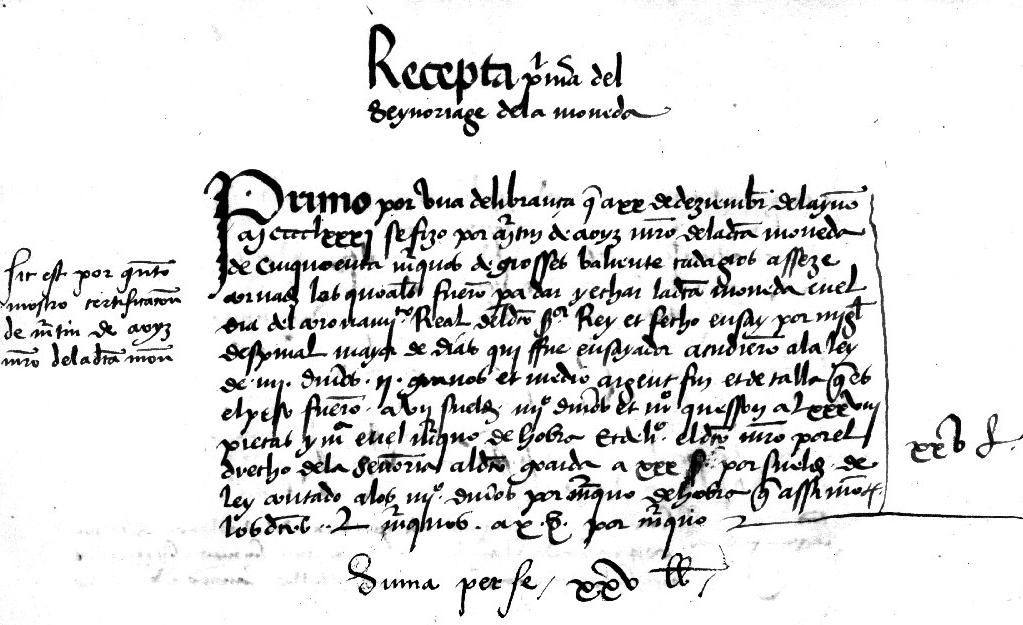
Courtesy of the General Archive of Navarre AGN, Box 164, Subentry of Document 21
Recepta Primera del Seynoriage dela moneda
Primo por una delibranza q a XX de dezembre del ayno MCCCCLXXXI se fizo por Martin d’Aoyz mtro deladcha moneda por cinquoenta marquos de grosses baliendo cada gros a seze cornados las quales fueron pa dar y echar la dcha moneda enel cra del coronamyento Real deldcho Senyor Rey fr Febo ensayado por Mygel deespinal mayor de edad que fue ensayador amonedado a la ley de IIII diners II granos et medio argent fin et de talla segun es elpeso fuero a VII sueldos IIII diners et medio queson a LXXXVIII piezas y medio enel marquo de l’obra. Et diho el dcho mtro por el drecho de la senyoraj a dcho goarda a XXX sueldos por sueldo Ley contado alos IIII dineros por marquo de hobra seguno assimos losdchos L marquos a X Sueldos por Marquo XXV Libras -> Suma Per Fe / XXV Libras
The gros coins which were distributed in the coronation ceremony were made out of 50 rough marks, had a silver content of 342 (4 deniers and 2 and a half grains) mils and an average weight of 2.765 grams (88.5 pieces were minted from each rough mark, which is 7 sous and four and a half deniers (7*12+4.5=88.5). This means that in total 50*88.5 = 4425 pieces were struck.
As a seigniorage, the payment for each fine silver mark (sueldo de ley) was supposed to be 30 sous/sueldos. Since a fine silver mark produced between 2.90 and 3 rough marks (without remedy or with a remedy of 3 grains), the seigniorage tax payable was rounded to 10 sueldos per rough mark. This was advantageous for the mintmaster, who assumed that all rough marks were made with a remedy of three grains, made out of a third of a fine silver mark (4 dineros de sueldo de Ley), at the lower end of the tolerance. Thus, these 50 rough marks generated a tax revenue of 25 livres.
Let us now check the number of gros and half gros coins that were struck during these five years. Unfortunately, the seigniorage accounts do not distinguish between gros and half groses, but in the entries, in the ones corresponding to several months it is mentioned and guaranteed that half groses were struck. Here is a summary of the gros and half gros quantities:
| 1481 | 1482 | 1483 | 1484 | 1485 | 1486 | Total | |
| Gross + Gross Half Amount | 4.425 | 12.136 | 39.190 | 2.920 | _ | _ | 58.671 |
| Rough Marks | 50 | 137 | 441,44 | 32,81 | _ | _ | 661,25 |
| Seigniorage Tax Revenue | 25 L | 68L 9S 11D | 220L 14S 4D | 16L 8S 1D | _ | _ | 320L 12S 4D |
| Hal-Groses are mentioned? | No | No | Yes | Yes | _ | _ | Yes |
Number of silver gros and half gros coins minted and their provided tax revenue
Overall, 58.671 Gros and half gros pieces were produced during these five years.
In 1485 and 1486, no gros coins were produced; the most prolific year was 1483. In this year and the following year, the production of half gros pieces was clearly mentioned and guaranteed in the accounts, without specifying the amount. In total, approximately 220 and a half marks of pure silver (about 55 kilograms) were minted. This number is rather small, especially considering the five years of minting activity and comparing with the numbers worked out during Queen Blanca's latest coinages. Looking at this data, we might be viewing a glimpse of the poor economic situation of the kingdom. The production of these roughly 60,000 gros and half gros left a seigniorage tax revenue of around 320 livres, equivalent to the one provided by the gold coins.
Let's now check what these gros and half-gros coins of King Francis Phoebus looked like. The gros specimens are also extremely rare, with probably only less than a dozen surviving or knows specimens so far. At least five are known in the case of the whole groses; two are in the hands of collectors and the other three are in the hands of the Bibliothèque Nationale de France, the Museum of Navarre and the Instituto Valencia de Don Juan in Madrid. The latter was studied and introduced by the expert Miguel Crussafont in 1982.
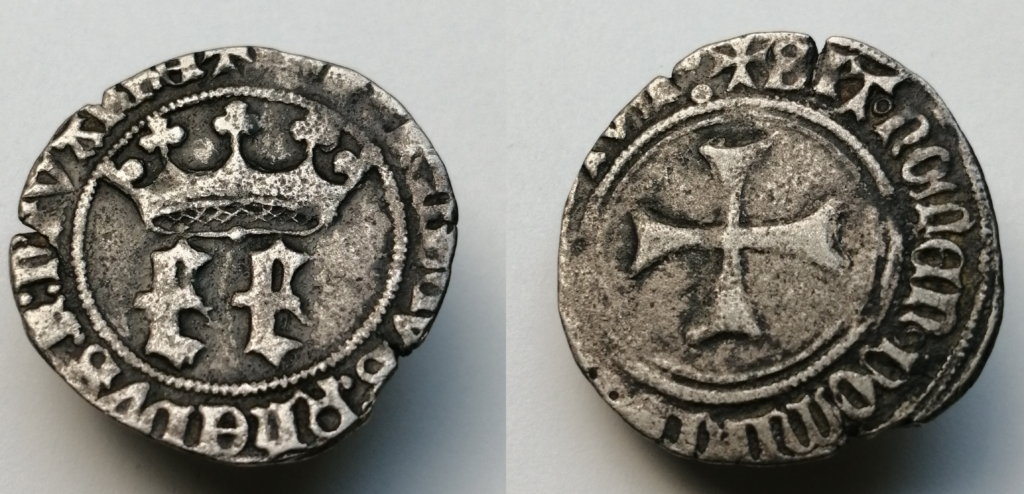
Silver gros minted in the name of King Francis Phoebus of Navarre (1479-1483) – 2.30gr – 24mm Diameter – Nominal silver content of 343 mils
Obverse: +FRANCISCVS FHEBVS R NAVARRE
Reverse: +SIT NOMEN DOMINI [BENEDICTVM]
David Arrarás Collection

Silver gros minted in the name of King Francis Phoebus of Navarre (1479-1483) – 2.58gr – 25mm diameter – nominal silver content of 343 mils – Auction Result of 3500 Euros
Obverse: +FRANCISCVS FHEBVS R NAVARRE
Reverse: +SIT NOMEN DOMINI BENEDICTVM
Beaussant Lefevre Lot 465, mercredi 30 octobre 2024 à 11h00
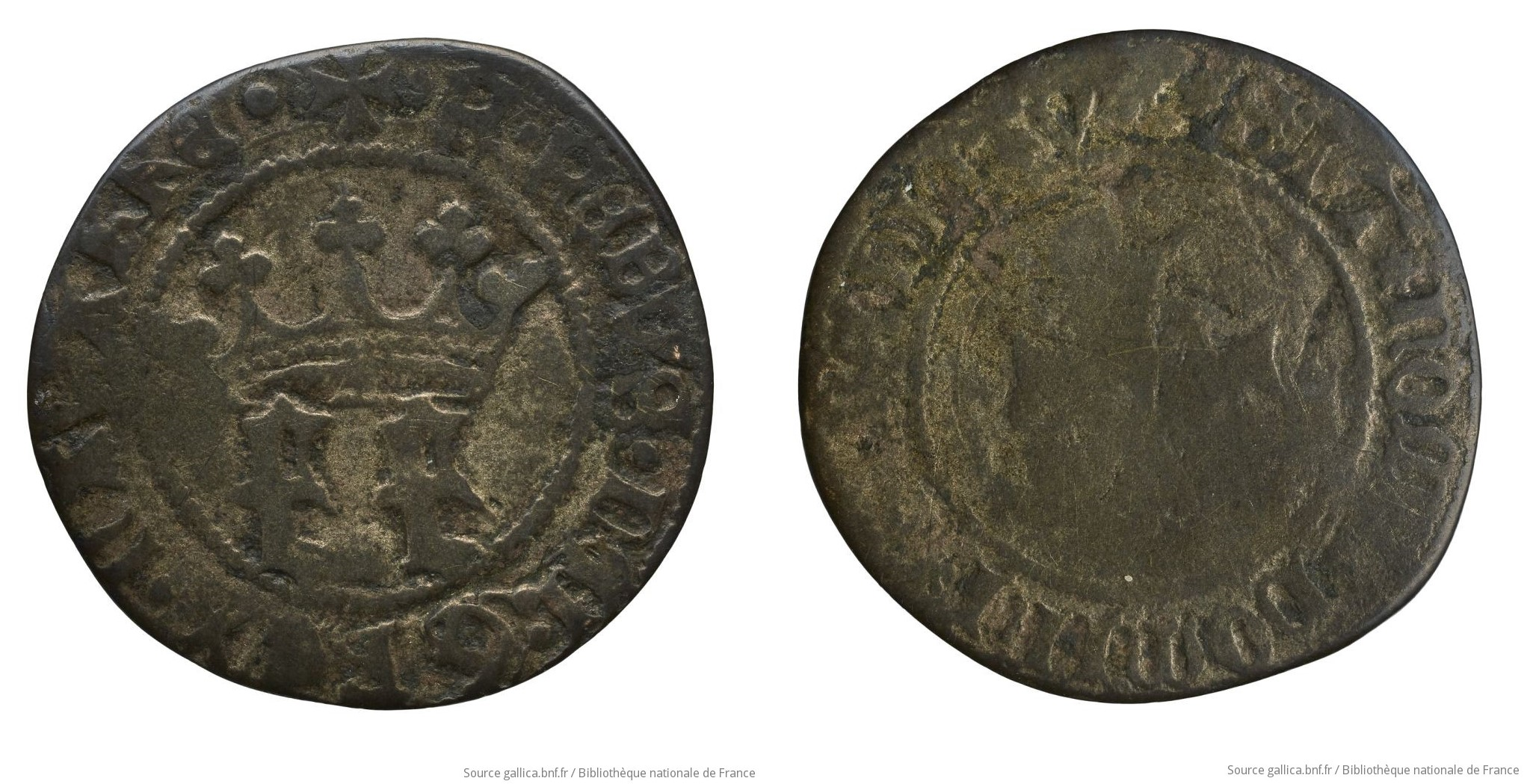
Silver gros minted in the name of King Francis Phoebus of Navarre (1479-1483) – 2.02 gr – nominal silver content of 343 mils
Obverse: F. FEBVS. DEI.G.REX.NAVARRE
Reverse: SIT*NOMEN*DOMINI*BENEDICTV
NATIONAL LIBRARY OF FRANCE
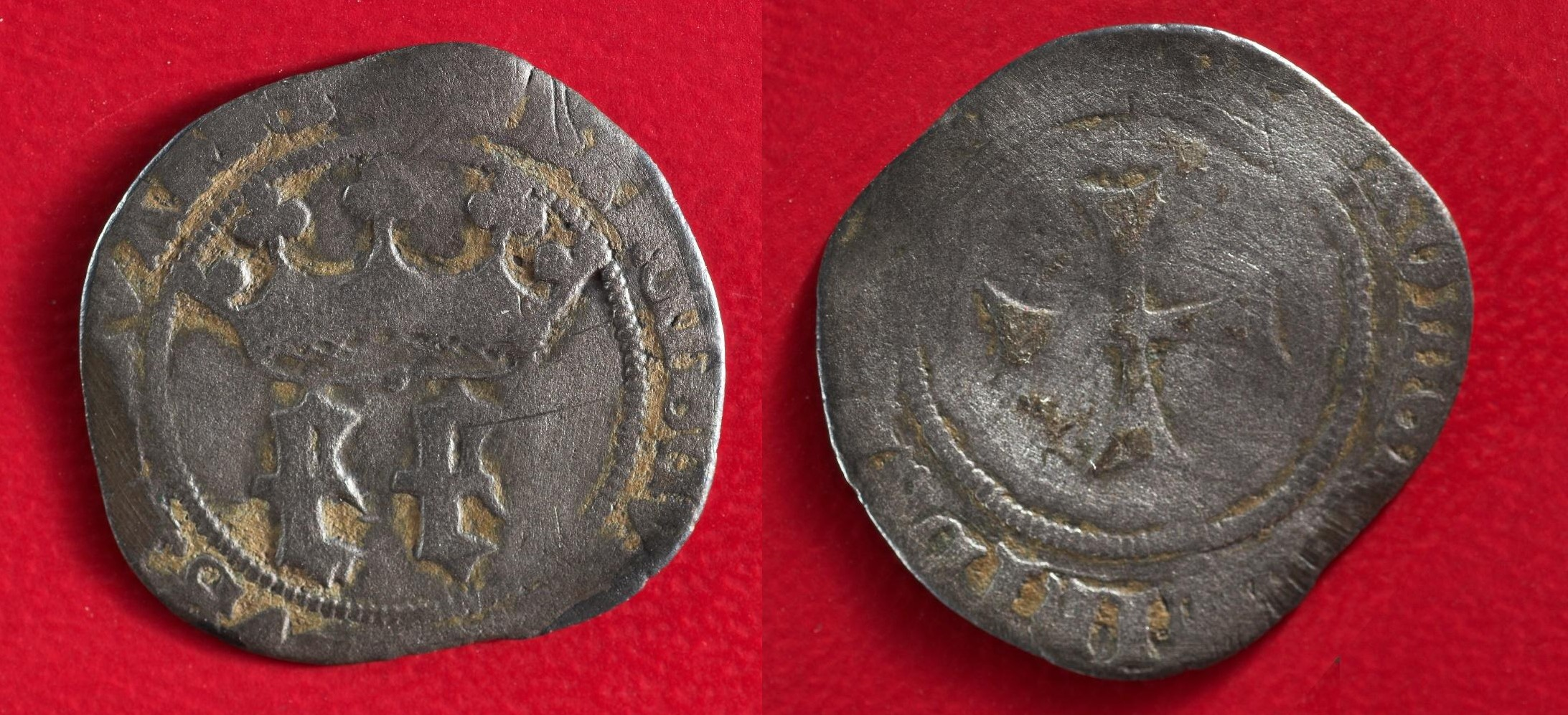
Silver gros minted in the name of King Francis Phoebus of Navarre (1479-1483) – 2.20 gr – 24mm Diameter – Nominal silver content of 343 mils
Obverse: +FRANCISCVS FHEBV[S R NA]VARRE
Reverse: [+SIT N]OMEN [DO]MINI BEN[EDICTVM]
MUSEUM OF NAVARRE object number N004838
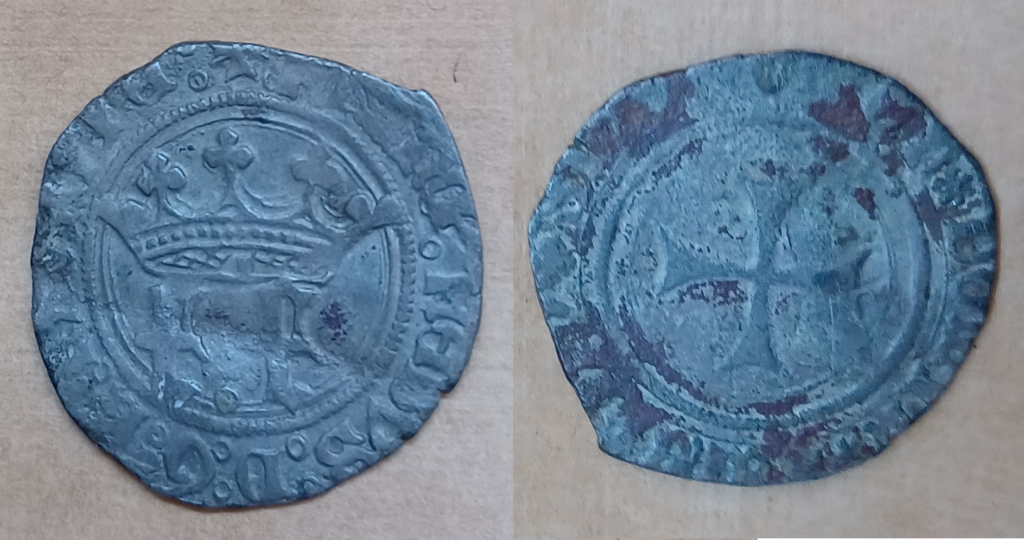
Silver gros minted in the name of King Francis Phoebus of Navarre (1479-1483) – 2.37 gr – 24mm Diameter – Nominal silver content of 343 mils
Obverse: FRANC FEBVS DG R NAVARRE
Reverse: +SIT ...N DOMINI BENEDI...
Courtesy of Instituto Valencia de Don Juan
The third and fourth specimens have not reached us in the best state of preservation.
We can notice that all of the previous exemplars have three different legends:
- FRANCISCVS FHEBVS R NAVARRE – Specimens from the Museum of Navarre, David Arrarás and the Paris auction
- F. FEBVS. DEI.G.REX.NAVARRE – Specimen of the National Library of France
- FRANC FEBVS DG R NAVARRE – Specimen of the Institute Valencia de Don Juan
Likewise, the specimen in the Museum of Navarre underwent a controversial restoration in the spring of 2021, before the opening of the museum's new numismatic room. Many other specimens also underwent a similar restoration, which, at least for myself as a numismatic collector, I find disappointing. After this restoration, the specimen now shines in the following way:
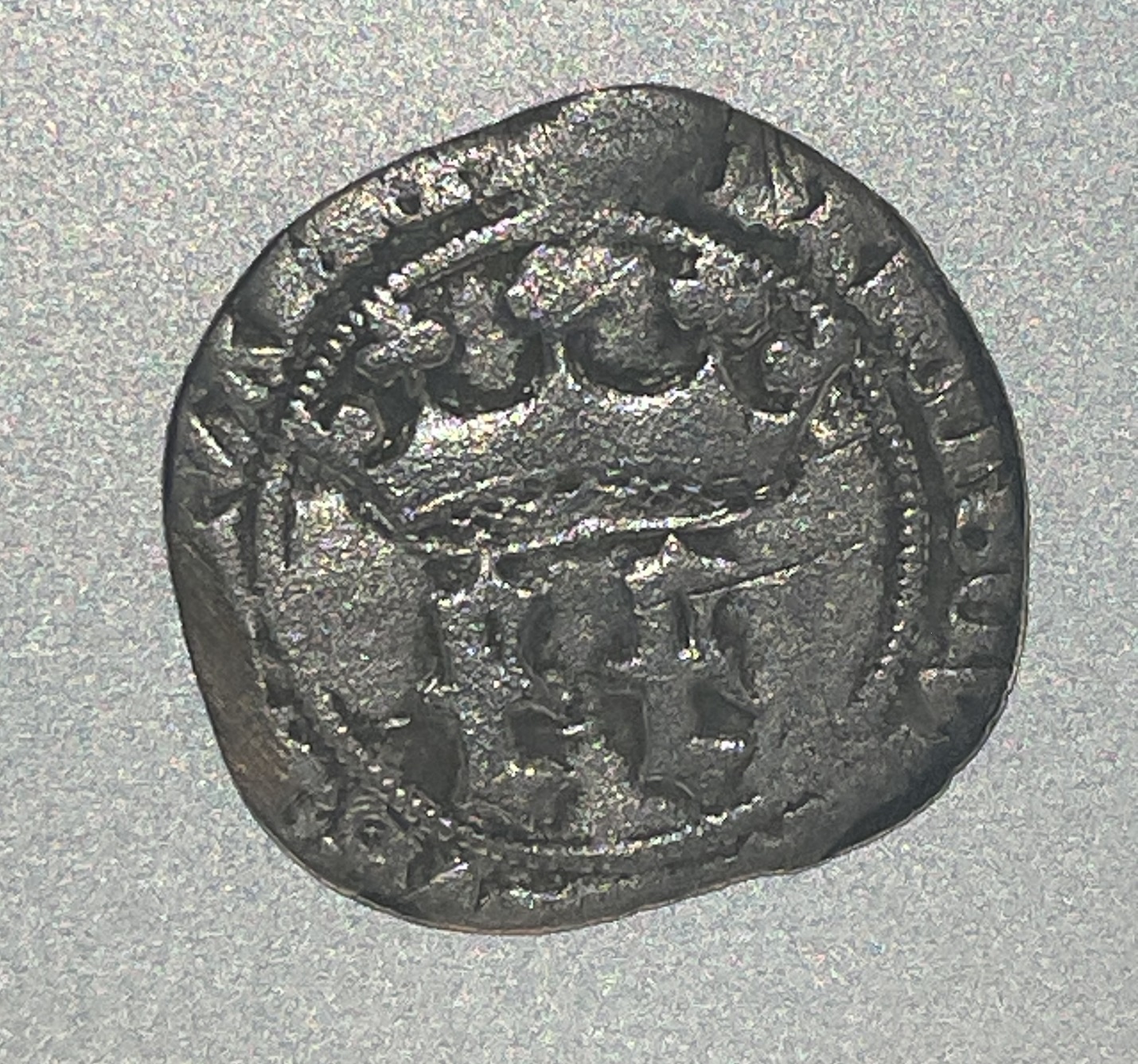
Silver gros minted in the name of King Francis Phoebus of Navarre (1479-1483) – 2.20 gr – 24mm Diameter – 343 mils silver content – The specimen on display in the exhibition hall, after undergoing restoration
Obverse: [+FRANCISCVS FHEBV[S R NA]VARRE
MUSEUM OF NAVARRE object number N004838
The only known half-gross specimen is kept in the treasure chambers of the Museum of Navarre and was discovered and made public by the expert Ibañez Artica in 2008. As far as I know, it has not undergone any restoration and should maintain the following appearance according to the photo taken back in 2018:
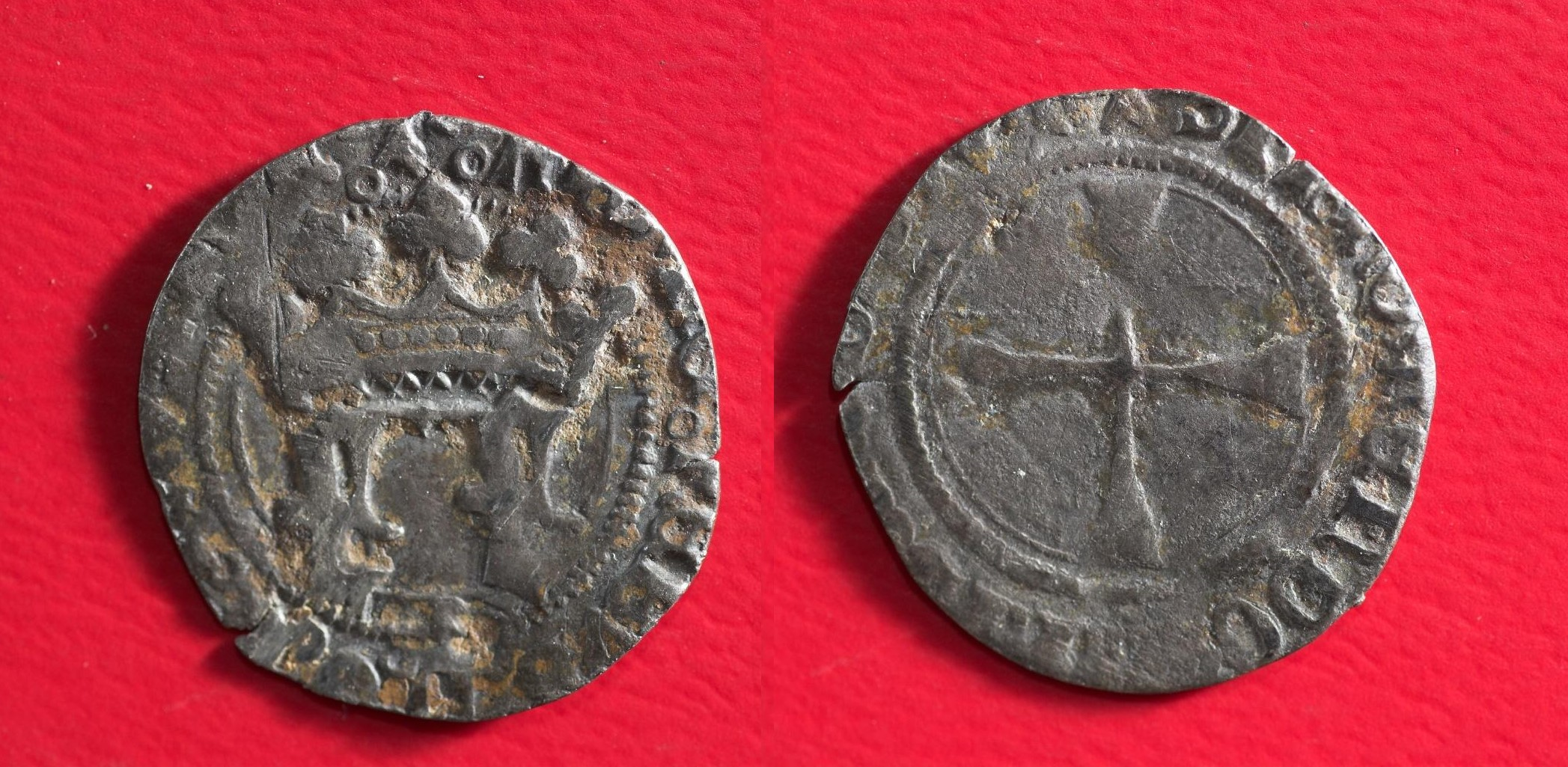
Silver half gros coin minted in the name of King Francis Phoebus of Navarre (1479-1483) – 1.10 gr – 18mm Diameter – Nominal silver content 343 mils
Obverse: FRANC FEBVS [DG RN]AVARRE
Reverse: +SIT NOMEN DOMINI BENEDICTVM
MUSEUM OF NAVARRE object number N007380
Let us now examine the details of the struck cornado coins.
One of the entries in the seigniorage accounts of the Cornado mintings is the one shown below, the first Cornados' entry corresponding to the year 1483. It has a couple of interesting details:
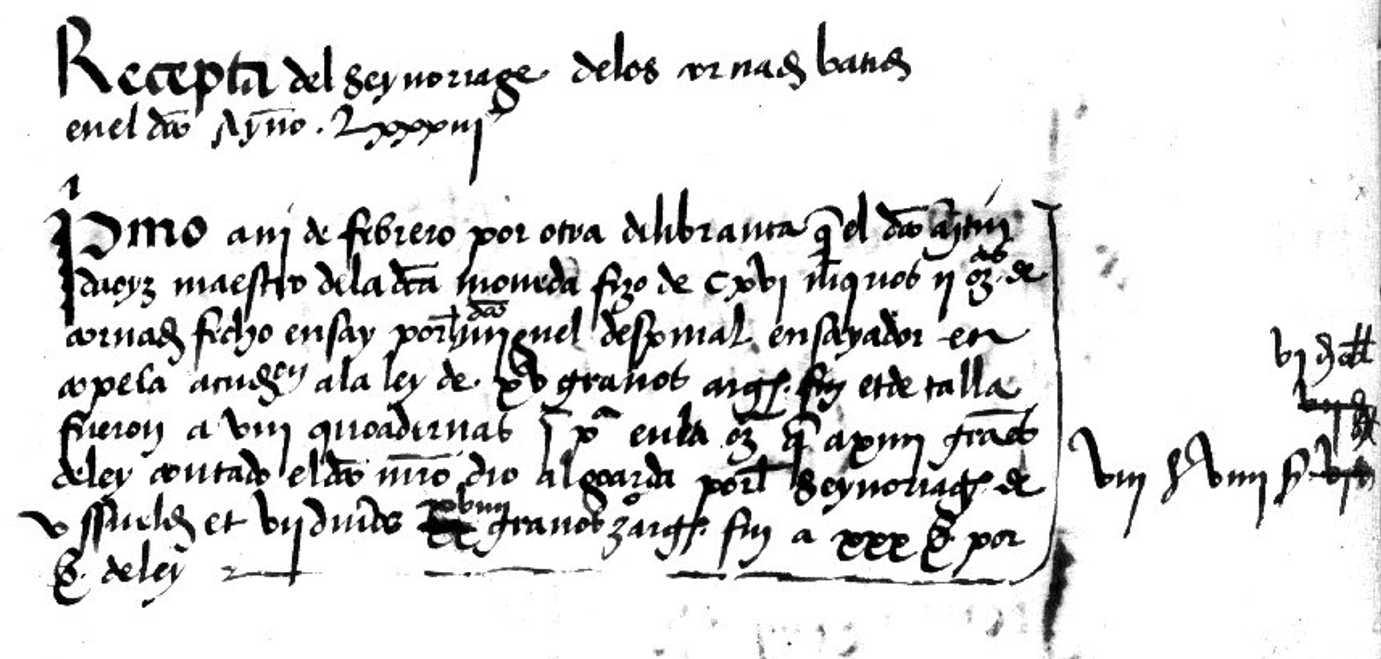
Courtesy of the General Archive of Navarre AGN, Box 164, Subentry of Document 21
Recepta del seynoriage delos cornados batidos en el dcho ayno LXXXIII
Primo a III de Febrero por otra delibranza q el dcho Martin d’Aoyz maestro de la dcha moneda fizo de CXVI marquos II Onzas de cornados fecho ensay port Myguel despinal ensayador en copela (aimagen?) a la ley de XV granos argent fin et de talla fueron a VIII quadernas I piezas en la onza que a XIIII granos deley contado el dcho mtro dio al goarda port senynoriaje de V sueldos et VII diners XVIIII granos argent fin a XXX sueldos por sueldo de ley. -> VIII L VIIII S VI Dineros
That is, on February 3rd, 1483, the mintmaster Martin de Aoiz delivered the result of the 116 marks and 2 ounces of cornado coins he had minted, and these were assayed by the assayer Miguel de Espinal by means of the cupellation method. with the expectation of a fineness according to the nominal law of fifteen grains of silver. The number of coins produced was 8 quadernas and one piece per rough ounce, that is, ((8*4) + 1 ) = 33 pieces in an ounce and 33*8 = 264 pieces in each rough mark; that is, a total of 116.25*264= 30,690 cornado specimens were minted according to this account entry. But the cornados delivered were said to have a silver fineness of fourteen grains, and Martin paid his seigniorage taxes based on these fourteen grains.
The struck cornados are said to have used 5 sous, 7 deniers and 19 grains of silver. This is quite interesting, because these 116.25 rough marks, with a silver content of 14 grains, should give us (116.25*1/12*14/24) = 5.6510 marks of consumed silver. This amount of consumed silver is a quantity of weight and should be expressed in marks, ounces and the like, but instead, it is expressed in sueldos/sous, deniers and grains, where a sueldo was a fine silver mark (sueldo de ley), divided into 12 deniers and a denier, in turn, into 24 grains. If these 5.6510 marks were converted to this base, it would give us 5 sous, 7 deniers and 19.5 grains, as shown in the exact calculations (well, actually, with an error of half a grain). Since the amount of silver used was known, the corresponding seigniorage tax can be easily calculated. If each sou or pure silver mark was subject to a tax of 30 shillings, a quick calculation will show that the tax flow generated was 8 pounds 9 shillings and 6 deniers, the same number as reported in the accounts.
Let's now check what kind of cash flow was generated by a pure silver mark which was struck into cornados:
| Name | Rough Marks Created from a Silver Mark | Nominal Number of Coins Issued from a Silver Mark | Seigniorage Tax | Minting Costs | Merchants' per Mark Silver Payment | Total | Monetary Outcome generated from a Silver Mark | Remaining discrepancy of Monetary outcome |
| Cornados | 19.2 | 4916 | 30 Sous/Sueldos | 50 Sous | 28 Pounds | 32 Pounds | 40L 19S 4D | 8L 19S 4D |
Monetary flow provided by a pure silver mark minted in cornado coins
From the above table we can conclude that the minting of a pure silver mark had an surplus monetary contribution of about two livres in the case of gros and half groses, but almost nine livres in the case of the cornados. These cornados were starting to land into what we would today call fiduciary coins.
And then let's see the total number of cornado specimens struck during these five years:
| 1481 | 1482 | 1483 | 1484 | 1485 | 1486 | Total | |
| Number of Cornados | _ | 8.160 | 71.720 | 69.370 | 38.488 | _ | 187.738 |
| Rough Marks | _ | 31,875 | 267,875 | 260,375 | 141,5 | _ | 701,63 |
| Seigniorage Cash Flow | _ | 2L 10S | 19L 7S 9D | 18L 19S | 10L 6S 4D | _ | 51L 3S 1D |
Number of minted Cornado coins and generated Seigniorage tax revenue
As it can be seen, the number of minted cornados was not large, 187.738 scarce units after five years of mintage, quite low for the entire kingdom. In the minting of these Cornados between 35 and 36 kilograms of pure silver were used, well below those used in the production of gros and half groses, and the seigniorage tax generated was therefore also six times lower in this case.
But what should not be forgotten is that, due to the difference between the nominal value of the cornado established by the royal court and the lower silver content of the cornado than it actually had, each of these pure silver marks provided the royal court or the merchant coiner with a profit of eight pounds, nineteen shillings and four dirhams. Therefore, these cornado mintings were extremely profitable.
In the case of the cornados, the specimens that have survived to our days are quite rare as well, not as rare as the gros and half groses, but certainly rare. Here are two specimens, one from the Museum of Navarre and the other from a well-known collector.

A billion cornado struck in the name of King Francis Phoebus of Navarre (1479-1483) – 0.70 gr – 17mm – nominal silver content of 52 mils
Obverse: F*F*DEI*G*REX*NAVARRE
Reverse: +SIT NOMEN DOMINI BENEDICTVM
MUSEUM OF NAVARRE object number N004837
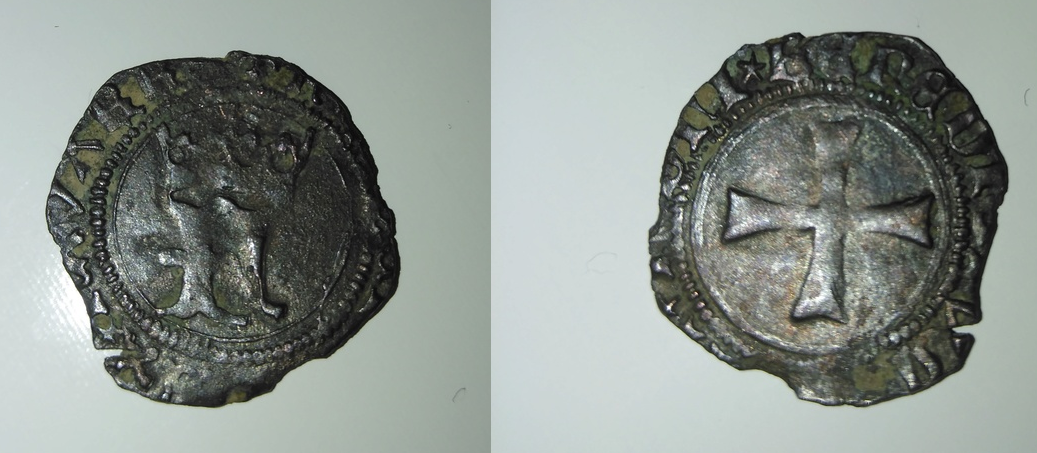
A billion cornado struck in the name of King Francis Phoebus of Navarre (1479-1483) – 0.79 gr – 17mm – nominal silver content of 52 mils
Obverse: F*F*DEI*G*REX*NAVARRE
Reverse: +SIT DOMINI BENEDICTVM
David Arrarás Collection
Finally, let's look at the so-called half-cornados or black deniers (dinero prieto). Here is the first entry in which these half-cornados appear in the seigniorage accounts, corresponding to February 19th, 1483:
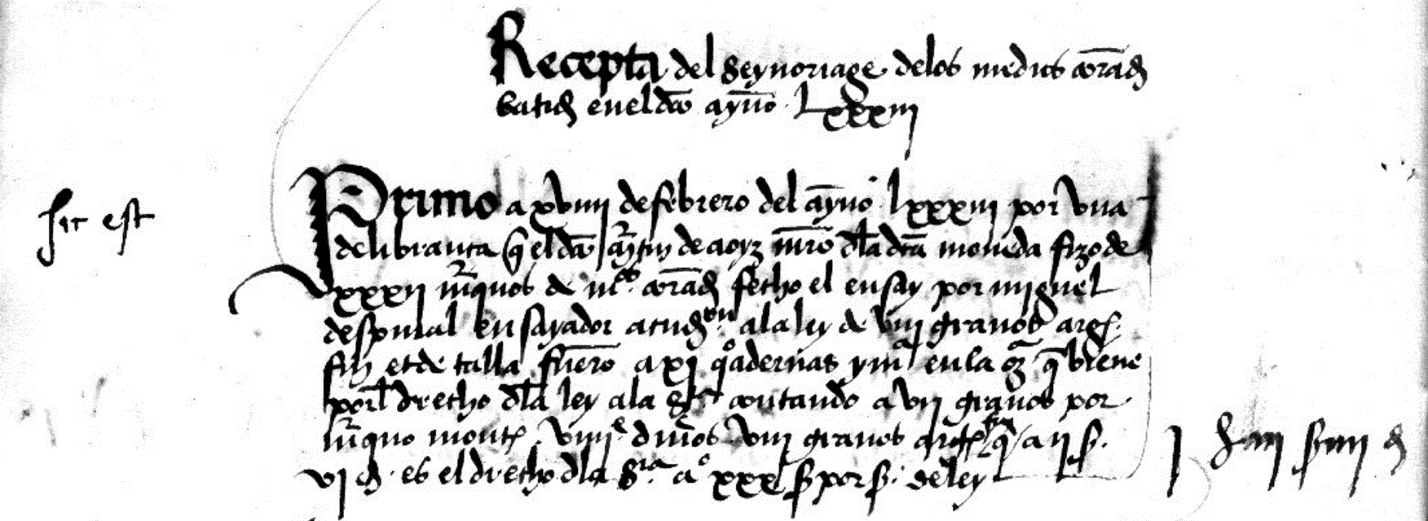
Courtesy of the General Archive of Navarre AGN, Box 164, Subentry of Document 21
Recepta del Seynoriage delos medios cornados batidos enel dcho ayno LXXXIII
Primo a XVIIII de Febrero del ayno LXXXIII por una delibranza q el dcho Martin de Aoyz mtro dla dcha moneda fizo de XXXII marquos de medios cornados fecho el ensay por Miguel despinal ensaydor (aimagen) a la ley de VIII granos argent fin et de talla fuero a XI quadernas y media en la onza que biene port derecho dla ley a la goarda contando a VII granos por marquo monta VIIII dineros VIII granos argent fin q a II sueldos VI diners es el derecho de la seynoria a XXX Sueldos por Sueldo de ley. -> I Libra III Sueldos IIII dineros.
On that day, February 19th, the mintmaster Martin de Aoiz delivered the production result of 32 rough marks. Once again, these half-cornados were examined by the assayer Miguel de Espinal. The theoretical fineness of these pieces was said to be 8 grains of silver, but the remedy of one grain accepted by the law was leveraged to pay the seigniorage tax according to the lower fineness value, which was 7 grains of silver. The average weight of the half-cornado pieces is expressed in the number of pieces which were produced out of one rough ounce, eleven and a half quadernas, that is, 46 pieces in one ounce, 368 pieces in each rough mark. Therefore, an average weight of 244.753/368 = 0.66 grams per coin is achieved.
The amount of silver which was used in this minting is then reported. According to the silver content of seven grains, the 32 rough marks would have consumed 0.7777 marks of pure silver. If this amount of marks is converted to a reference of sous, deniers and grains (one sueldo is twelve deniers, one denier is 24 grains), it would give us nine deniers and eight grains, the same number which is shown in the accounts. Since the usage of a pure silver mark had a seigniorage tax of 30 sous, the production of a pure silver denier had to pay a tax of one twelfth of that amount, that is, two sueldos and six deniers. As a result of all this, the pure silver content of nine deniers and eight grains had to pay a tax of 23 sueldos and 4 deniers, that is, one pound, three sueldos and four deniers. The numbers in the accounts are also precise in this case.
Once again, let's see what kind of monetary outcome a pure silver mark generated once converted into half-cornado pieces:
| Name | Rough Marks Created from a Silver Mark | Number of Coins Produced from a Silver Mark | Seigniorage Tax | Minting Costs | Merchants' per Mark Silver Payment | Total | Monetary Outcome generated from a Silver Mark | Remaining discrepancy of Monetary outcome |
| Negrete - Half Cornado | 36 | 12.672 | 30 Sous/Sueldos | 50 Sous | 28 Pounds | 32 Pounds | 42L 16S | 10L 16S |
Monetary outcome of a pure silver mark converted into half-cornados
We can once again highlight that the minting of a pure silver mark had an unjustified monetary contribution of around two pounds in the case of gros and half groses, almost nine pounds in the case of cornados and ten pounds and sixteen sous in the case of half cornados. The half cornados were also on the way to being called fiduciary coins.
The half-cornados were only produced over a three-year period, starting in 1483 and the next two years. Let's look at the total number of half-cornados produced in these three years:
| 1481 | 1482 | 1483 | 1484 | 1485 | 1486 | Total | |
| Number of Half-Cornados | _ | _ | 38.432 | 38.364 | 26.400 | _ | 103.196 |
| Rough Marks | _ | _ | 105 | 104,25 | 75 | _ | 284,25 |
| Seigniorage Tax Revenue | _ | _ | 3 L 16 S 5 D | 3 L 16 S | 2 L 14 W 8 D | _ | 10 L 7 W 1 D |
Quantity of half-cornado coins minted and their generated tax revenue
Once again, the number of minted half-cornados is not big, a mere 103,196 pieces over the three years, again quite scarce for the entire kingdom. In the production of these half-cornados about seven kilograms of pure silver were used, well below those used in the making of the whole cornados, and the seigniorage tax revenue generated was five times lower than in this case.
But here too, due to the difference between the nominal value of the half-cornado established by the royal court and the lower silver content of the coins than they should have been, each of these pure silver marks brought the royal court or the mintmaster a profit of ten pounds and sixteen shillings. Again, this made the minting of these half-cornados very profitable.
As could be suspected, in the case of half-cornado coins, the specimens that have survived to our days are rare, this time not as rare as the whole cornado coins, but still quite rare. Here are a couple of exemplars that have appeared at auctions:
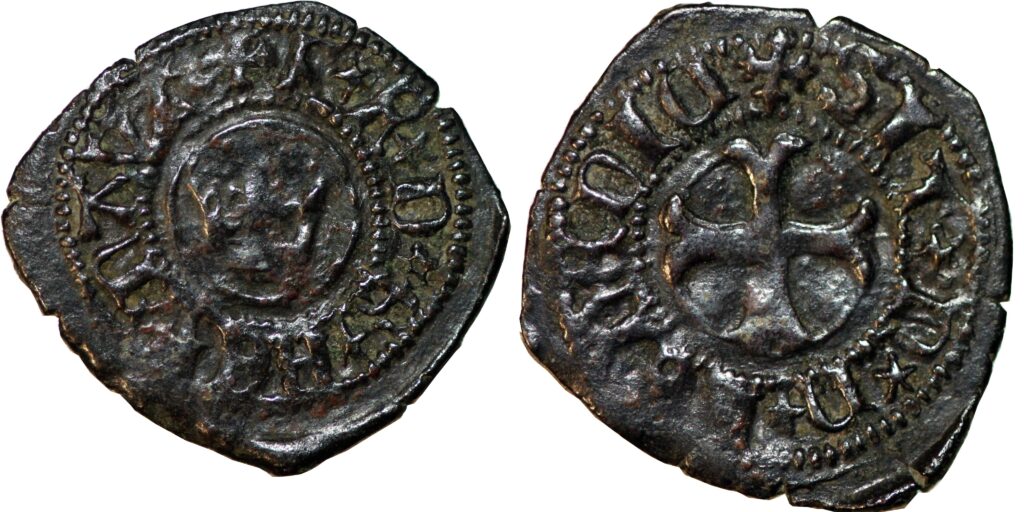
Half-cornado of billon, carved in the name of King Francis Phoebus of Navarre (1479-1483) – 0.70 gr – 15mm – nominal silver content of 27 mils
Obverse: F.F.D.G.REX.NAVA
Reverse: + SIT.NOMEN.DOMIN
RICARDO ROS COLLECTION
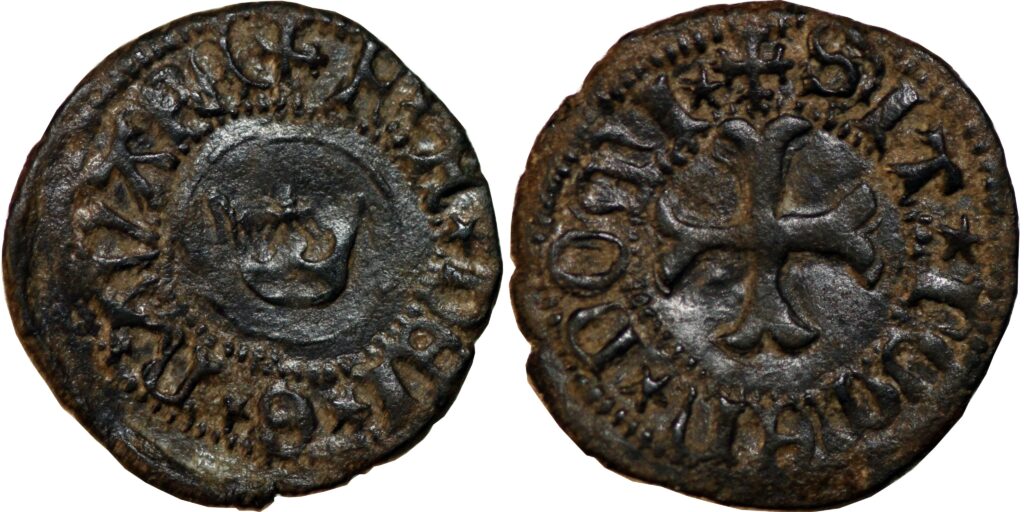
Half-cornado of billon, carved in the name of King Francis Phoebus of Navarre (1479-1483) – 0.84gr – 15.5mm – nominal silver content of 27 mils
Obverse: F.F.DEI.G.NAVARE
Reverse: + SIT.NOMEN.DOMI
DIEGO LOPEZ COLLECTION
Before taking a look at the expenses, let's make a summary of all the coinage produced in these five years:
| 1481 | 1482 | 1483 | 1484 | 1485 | 1486 | Total | |
| Number of Gold Coins | _ | 2.246 | _ | 1.111 | 310 | 1.131 | 4.798 |
| Gross/Half-Gross Quantity | 4.425 | 12.136 | 39.190 | 2.920 | _ | _ | 58.671 |
| Number of Cornados | _ | 8.160 | 71.720 | 69.370 | 38.488 | _ | 187.738 |
| Number of Half-Cornados | _ | _ | 38.432 | 38.364 | 26.400 | _ | 103.196 |
Summary of coins minted each year and total numbers
These seigniorage and coinage accounts have many other interesting aspects. In some cases, instead of reporting the income collected in seigniorage taxes, the cash outflows as payment of incurred expenses was also reported. Many of the cash outflows went to the salary payments for various officers (the guard itself, the assayer, the engraver and the general of the coins). Other outflows reflect the payments made to the iron and steel worker of the stacks and dies. The mint house itself also had its own repair works, especially the replacement of the roof and the purchase of the necessary tools and instruments for the minting of the coins, which also included its written receipts.
But among these accounting records, there are a couple that we should pay close attention to. Here is the first one:


Courtesy of the General Archive of Navarre AGN, Box 164, Subentry of Document 21
Item a VII de Agosto del ayno sobre dcho de LXXXIII fueron delibradas a Martin Cruzat goarda general dla dcha moneda el quoal fue nombrado por sus altezas por renunciación fecha de ymy Peton de Campront de Nabarrens al dicho Martin Cruzat como resa por su probado desenpen por la Reyna ntra Señora a X días de Mayo del Ayno LXXXIII al quoal día Martin Cruzat delibro por sus gages assi como al ensayador por los meses de mayo junyo et julio pasado a VII libras X sueldos por mes. – > XXII Livres X sous
Martin Cruzat is said to have received the post of general guard of the royal coins on 10th May 1483. His salary was considerably lower than that of a guard or deputy guard and he was given the responsibility after the resignation of a Bearnois (Peton de Campront, from Navarrenx). Martin's duties seemed to be related to control tasks and perhaps the meaning of "general" or overall could reflect his role in both Bearnaise and Navarrese coinage. This would explain the low salary he received (seven and a half livres, the equivalent of the assayer's), which may have been the same amount he received from the Bearnaise mint.
But the three passages that follow are even more interesting. In these, we see a new coin naming that appears for the first time in Navarrese history up to the current end of 15th century, the silver real.
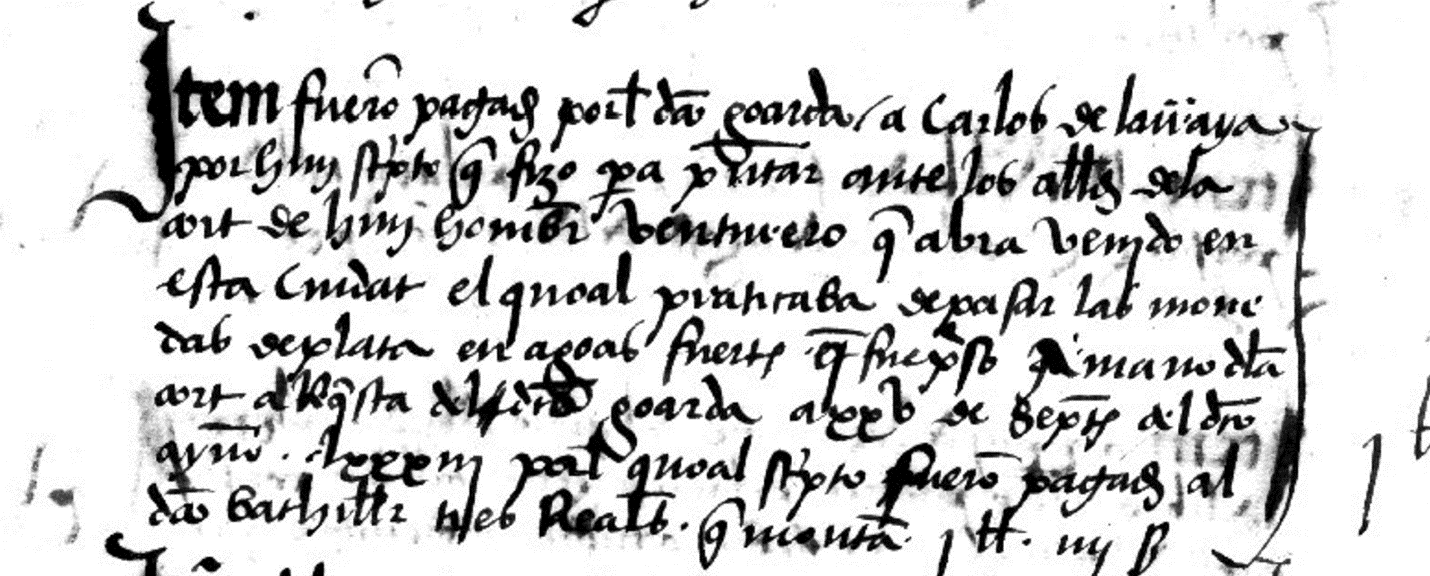
Courtesy of the General Archive of Navarre AGN, Box 164, Subentry of Document 21
Item fueron pagadas port dcho goarda a Carlos de Larraya por ymy pleito que fizo pa pintar ante los altos dela cort de lun hombre benturero que abra benydo en esta ciudat el quoal praticaba repasar las monedas deplata en agoas fuertes q fue xpto a mano dla cort al Recepta del dcho goarda a XXV de Sept del dcho ayno LXXXIII pal quoal pleyto fueron pagadas al dcho Carlos tres reales q monta I libra IIII sueldos
This cash flow statement explains the payment of the costs associated with a case brought to the courts of the royal court, where supposedly there was an adventurer who came to Pamplona, who retrieved silver from coins with the help of acids. The law severely punished these behaviors and the first payment of the costs associated with the case that had begun was said to have been worth three reales, a total of one pound and four shillings. That is, one of these reales was worth 8 sous.

Courtesy of the General Archive of Navarre AGN, Box 164, Subentry of Document 21
Primo a XIII de Dezembre del ayno MCCCCLXXXLI se libro a Pasquoal de Aranguren secretario por la escriptura del mandamyento q fue dado pa el batimiento dla dcha moneda V reales et deren assi port sello del dcho mandamiento a la chancilleria, Martin deliart secretario III escudos de oro q a IIII libras VIII sueldos montan todos – > XV Libras IIII sueldos
The next outflow reports the payment to the secretary Pascual de Aranguren. He is said to have prepared the document of the minting order created in November 1481 and received five reales in return. In addition, three gold shields (Escudos) were paid to the secretary of the chancery in return for the stamp that this minting order received. These gold shields were worth four pounds and eight shillings, less than the four pounds and twelve shillings of the gold coins of Febo that were about to be minted and that we have already mentioned. Since a total of 15 pounds and 4 shillings were paid, these five reales were worth 40 shillings, which means that each real in this passage is given a value of 8 shillings again.

Courtesy of the General Archive of Navarre AGN, Box 164, Subentry of Document 21
Item a XV de Febrero del dcho anyo de MCCCCLXXXII pagado a Pasquoal de Amezaga secretario por la escriptura de otro mandamyento q fue dado por la muy alta y excelente señora la Reyna Dona Cathelina q sucedió en ese su Regno por muerte del Señor Rey Febo de gloriosa memoria por la quoal dio al dcho secretario VIII Reales y al sello dla Chancilleria por la expedición II escudos de oro a IIII libras VIII sueldos que monta todo -> XII libras
This last passage tells us what was paid to the secretary Pascual de Amezaga. Corresponding to february of the year 1482, he is said to have prepared a document for the minting order confirmed by Queen Catherine, which states that he received eight reales in compensation.
But how could Queen Catherine have issued this edict around February 1482, if King Francis died in January 1483? Catherine was not queen in 1482.
In exchange of the stamp, two gold shields (escudos) were paid to the chancellery, again in gold coins worth four pounds and eight shillings. Since a total of 12 pounds were paid, these eight reales were worth 64 shillings (3 pounds and 4 shillings), that is, each real was worth 8 shillings, after taking into account the 8 pounds and 16 shillings of the value of the two gold coins.
These gold shields (escudos) should mirror those struck in the second half of the reign of John II (1458-1479). The specimens are very rare and the only one I know of is in the French National Library:
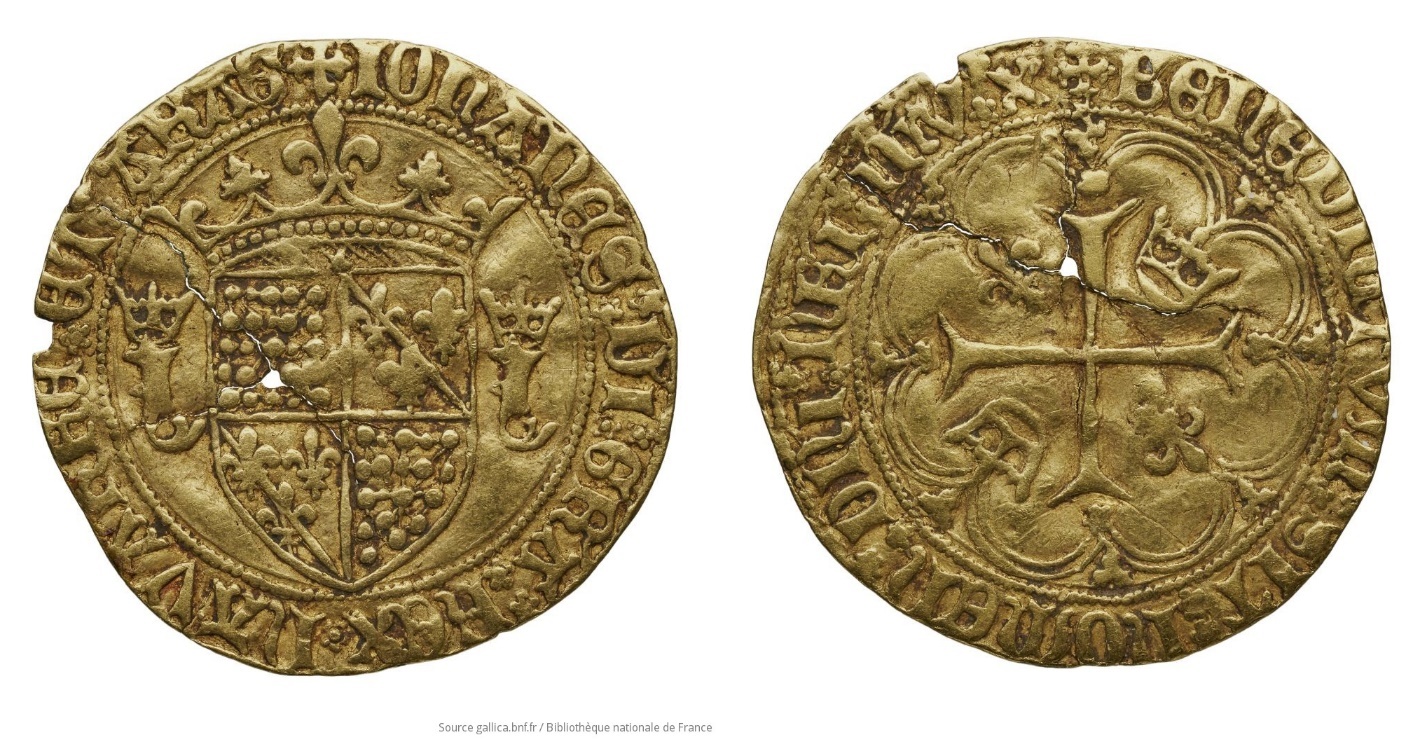
Gold Shield/escudo of Navarre, struck between 1458 and 1479 – 4.38gr
Obverse: IOHANES:DI:GRA:REX:NAVARRE:ET:ARAG
Reverse: BENEDICTVM:SIT:NOMEN:DNI:NRI:IHV:X:
Specimen of the National Library of France (BNF)
But the weight of these shields of King John was higher than the gold coins of Francis or Catherine's time (4.40gr vs 3.30gr, despite the lower accounting value of 4 pounds and 8 shillings) and although we have no documentation of the gold content of the former, we can say that these gold shields indicated in the accounts were given the accounting value of the gold shield coins during John's reign, rather than contemporary physical coins.
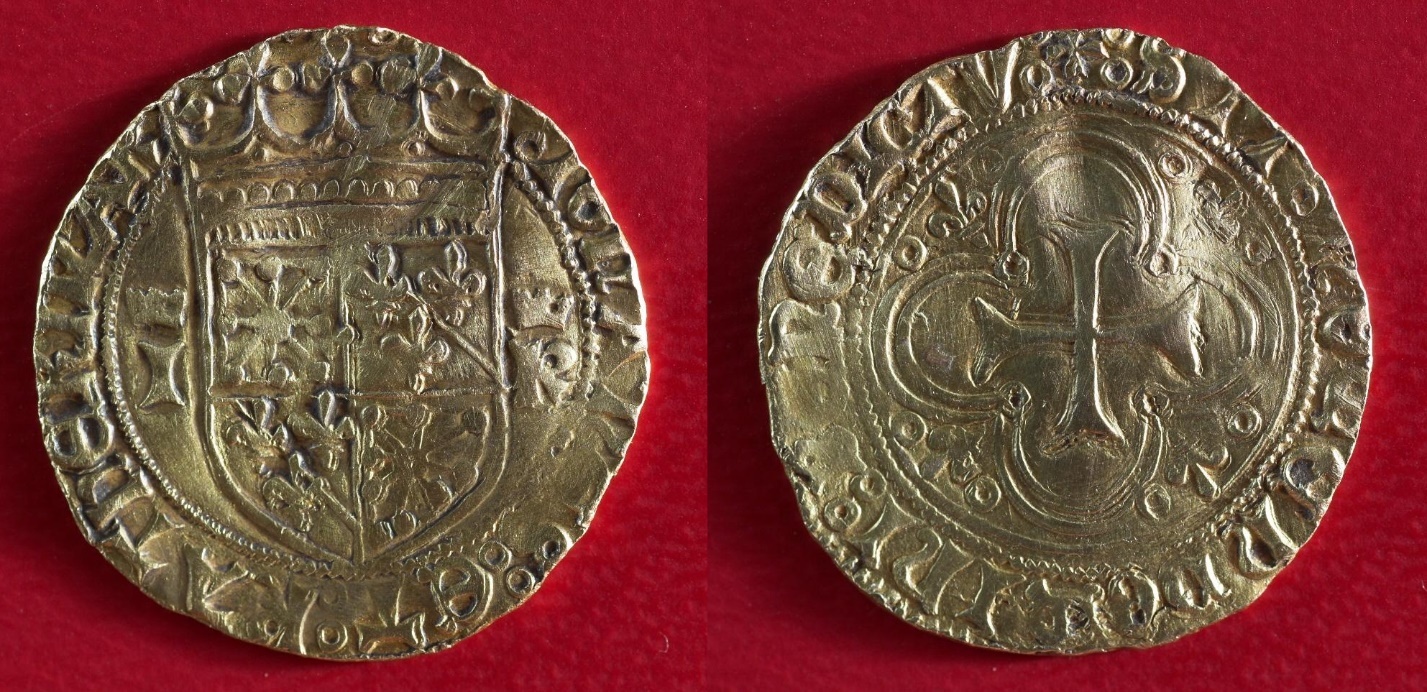
Gold real minted in the name of Queen Catherine of Navarre (1483-1517) and King John III (1484-1516) from 1495 onwards – 3.30 gr – 23mm Diameter – Nominal gold content 933 mils
obverse: +IOHANES:ET:KATHERINA:R
Reverse: +SIT:NOMEN:DOMINI:BENEDICTV
MUSEUM OF NAVARRE object number N004846
If we return to silver reales, the value of 8 shillings provided by the accounts would clarify something to us. One silver real equated to four twelve-cornado gros accounting coins or to three before shown sixteen-cornado physical silver gros coins of Francis . But which were these silver reales and what did they look like? Were there physical coins like these in Navarre?
Silver reales oficially began to be minted in 1495 under the reign of queen Catherine and King John, about ten years after the time mentioned in these accounts. The weight of those reales was around the weight of the groses of Francis, slightly less, but in silver content they had about three times higher content than the gros. Therefore, the equivalence between one real to three groses of Francis represented by these accounts is entirely reasonable.
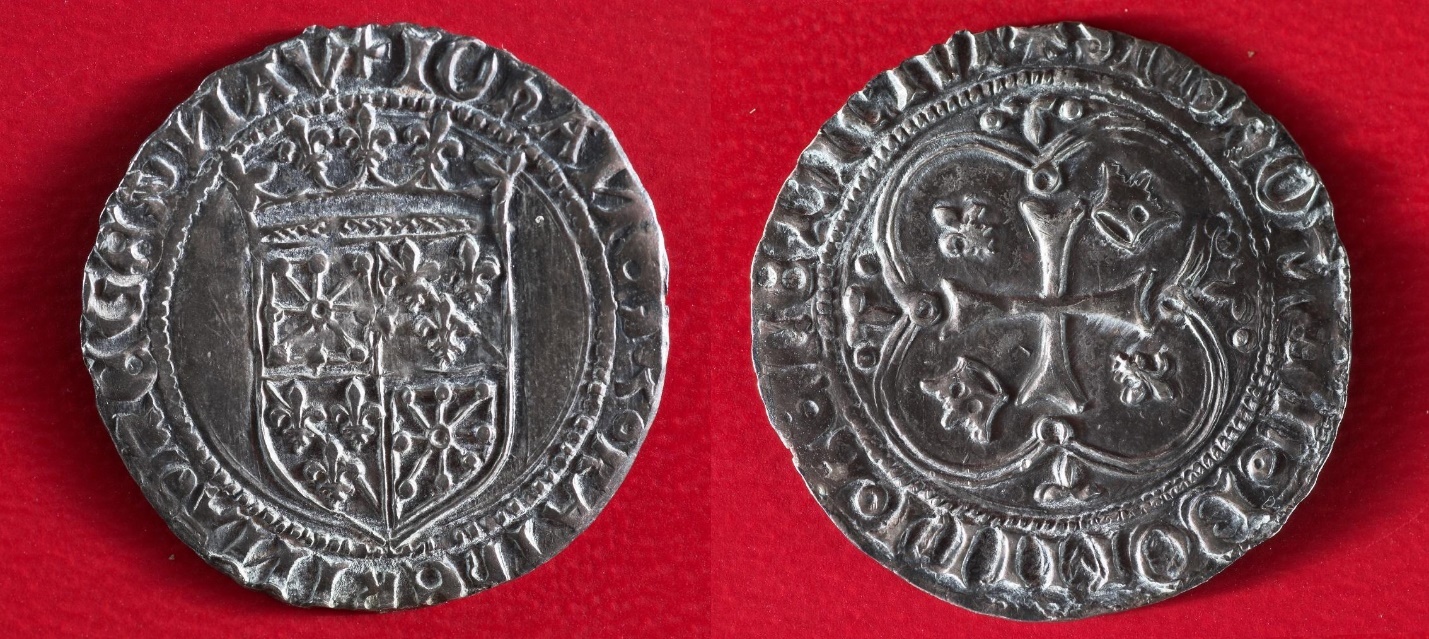
Silver real minted in the name of Queen Catherine of Navarre (1483-1517) and King John III (1484-1516) from 1495 onwards – 2.40 gr – 26mm Diameter – Nominal silver content 926.66 mils
Obverse: +IOHANES:Z:KATHERINA:REGES:NAV
Reverse: +SIT:NOMEN:DOMINI:BENEDICTVM
MUSEUM OF NAVARRE Object number N004856
Pedro Marzilla de Caparroso left his guard position around 1493-1494 and, as can be seen in the accounts, after he left the guard position he cleared and cleaned the accounts, ready to present them to the Chamber of Accounts. This could explain the reference in the accounts to a coin first minted in 1495. Or perhaps he is referring to a foreign real, but I would not consider this possibility for the moment. The name of the Tarja coin is also mentioned in the outflows, and these also began to be minted in the second half of the last decade of the century.
This delayed cleaning and writing of the accounts would explain another incident that has come to light. As we have seen, in numerous passages of the coinage accounts, Catherine appears as Queen from the beginning of 1482 onwards. But King Francis Phoebus died at the end of January 1483 in the palace of Pau. How can this time-matching error be explained? After consulting a couple of experts, we believe that Pedro, or one of his copyists, could have had a wrong basis for the year of the king's death, and this error spred throughout the accounts. However, this error does not detract from the value of this truly excellent document!
Before we finish, let's look at the number of dies and piles used.

Courtesy of the General Archive of Navarre AGN, Box 164, Subentry of Document 21
Item assinto contado con Peton de Sant Johan puynalero por una talla se fallaron aber fecho IIII dozenas de trosseles a II Sueldos y VI dineros pagados a, et VIIII pillas pa tarjas et cornados a V sueldos que montan VIII libras V sueldos las quales le pague en tres bezes al dcho Peton – > VIII livres V sous
The amount received in return for each of the previously described new pile and dies is clearly shown in this passage. In some cases, Peton “Punyalero” would receive payment for new dies, but in others, after renewing and steeling the old dies, he would receive a smaller monetary reward. The piles would have undergone a similar recycling, but this is not reflected in the accounts.
The following table summarizes the number of piles and dies used, both new and restored, that the coinage accounts reveal. I have compared the number of piles and dies with the number of coins minted, so that we can have a better perspective.
| 1481 | 1482 | 1483 | 1484 | 1485 | 1486 | Total | |
| Number of Gold Coins | _ | 2.246 | _ | 1.111 | 310 | 1.131 | 4.798 |
| Gross/Half-Gross Quantity | 4.425 | 12.136 | 39.190 | 2.920 | _ | _ | 58.671 |
| Number of Cornados | _ | 8.160 | 71.720 | 69.370 | 38.488 | _ | 187.738 |
| Number of Half-Cornados | _ | _ | 38.432 | 38.364 | 26.400 | _ | 103.196 |
| Total | 4.425 | 22.542 | 149.342 | 111.765 | 65.198 | 1.131 | 354.403 |
| 1481 | 1482 | 1483 | 1484 | 1485 | 1486 | Total | |
| Piles | 8 | 26 | 8 | 42 | |||
| Dies | 16 | 130 | 36 | 182 | |||
Summary of the number of piles and dies reported by the coinage accounts
On average, each pile produced 8,438 coins and each die produced 1,947. Let's take these numbers into account, because they are very significant!
Bibliography:
Monedas de FRancisco Febo, efímero rey de Navarra (1479-1483) – Miguel IBAÑEZ ARTICA – 2017 – link
Senoreaje Y Produccion Monetaria En El Reino De Navarra A Fines del Siglo XV – Juan Carrasco – 2003 – link
Moneda medieval navarra –Manual de Numismatica – Miguel IBAÑEZ ARTICA – 2021
Monedas navarras inéditas de Francisco Febus (1479-1483) y de Catalina y Juan de Labrit (1483-1512) – MIQUEL CRUSSAFONT i SABATER – ACTA NUMISMATICA N°12 -1982 – link
LA MONEDA EN NAVARRA – MUSEO DE NAVARRA – EXPOSICION DEL 31 DE MAYO AL 25 DE NOV 2001. Miguel Ibáñez Artica – link
CATÁLOGO GENERAL DE LA MONEDA DE NAVARRA – Ricardo Ros Arrogante – 2013 – Altaffaylla argitaretxea
Excel Sheet of Minting and Seigniorage Tax accounts – Monakotik – Link
NUMISMÁTICA MEDIEVAL DE NAVARRA III: ACUÑACIONES DE BLANCA Y JUAN (1425-1441), CARLOS, PRÍNCIPE DE VIANA (1441-1461), JUAN II (1441-1479) Y FRANCISCO FEBO (1479-1483) – GACETA NUMISMATICA 199 Junio 2020- Miguel IBAÑEZ ARTICA – 2020
ALGUNAS CONSIDERACIONES SOBRE LA MONEDA NAZARÍ – Dr. D. Alberto Canto García -2004

